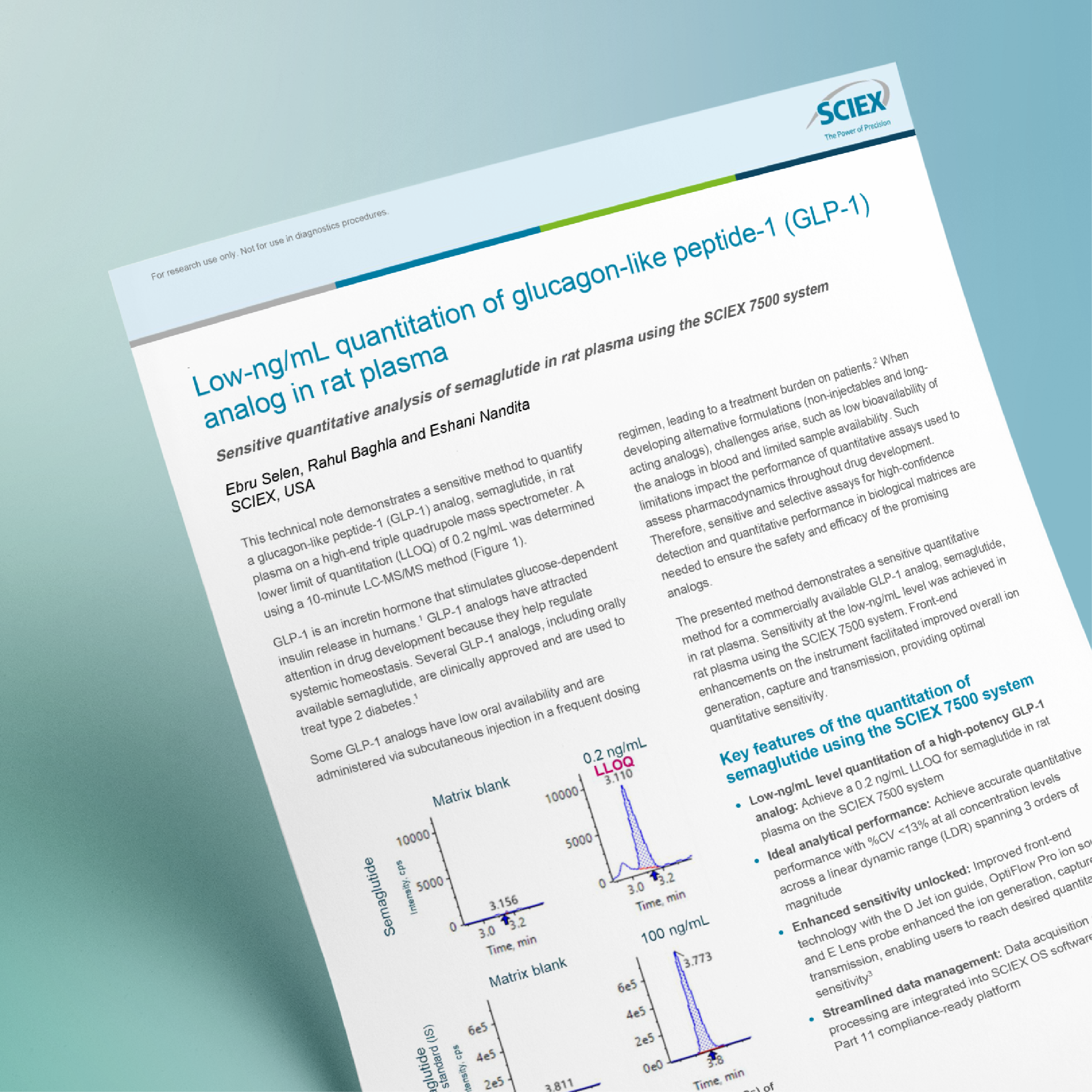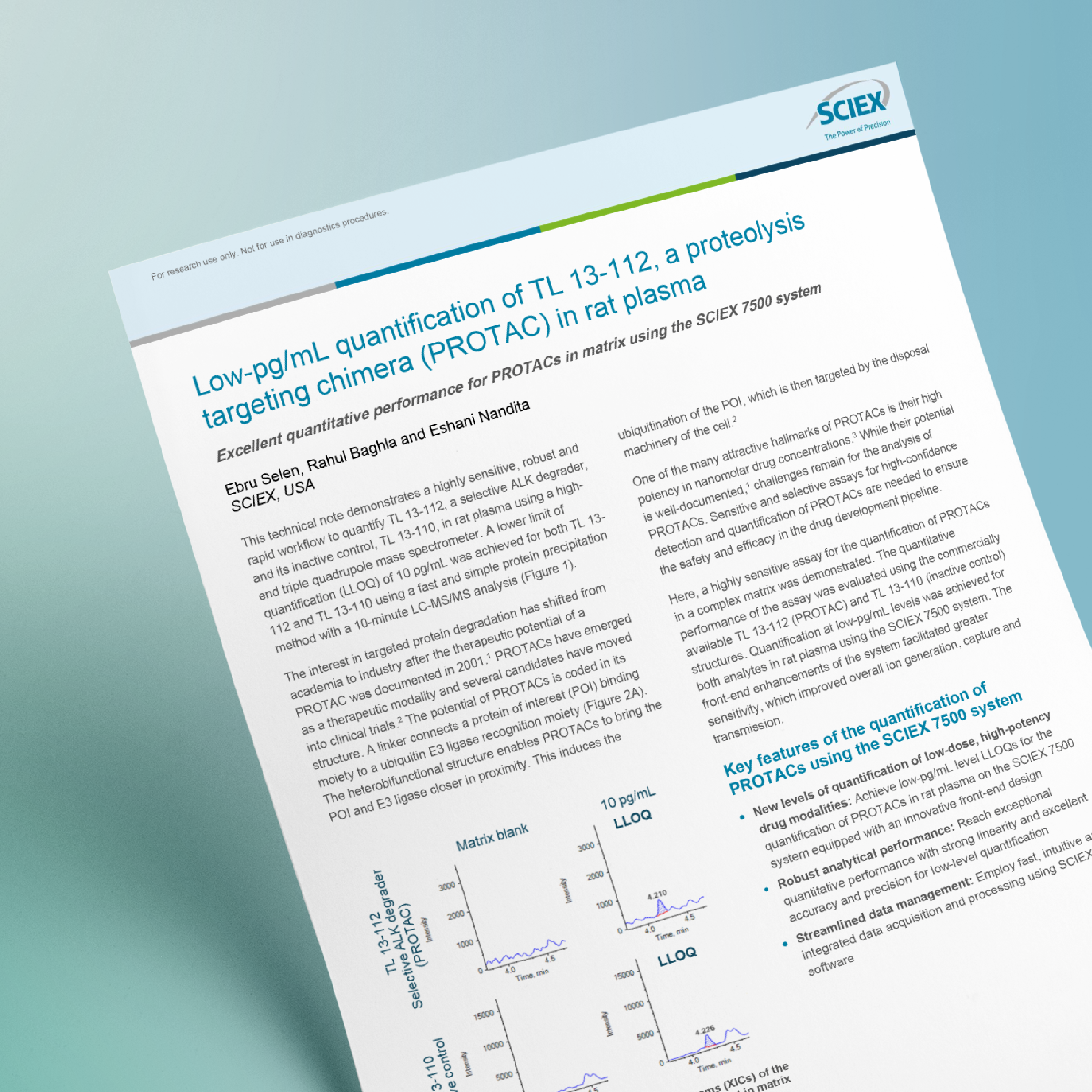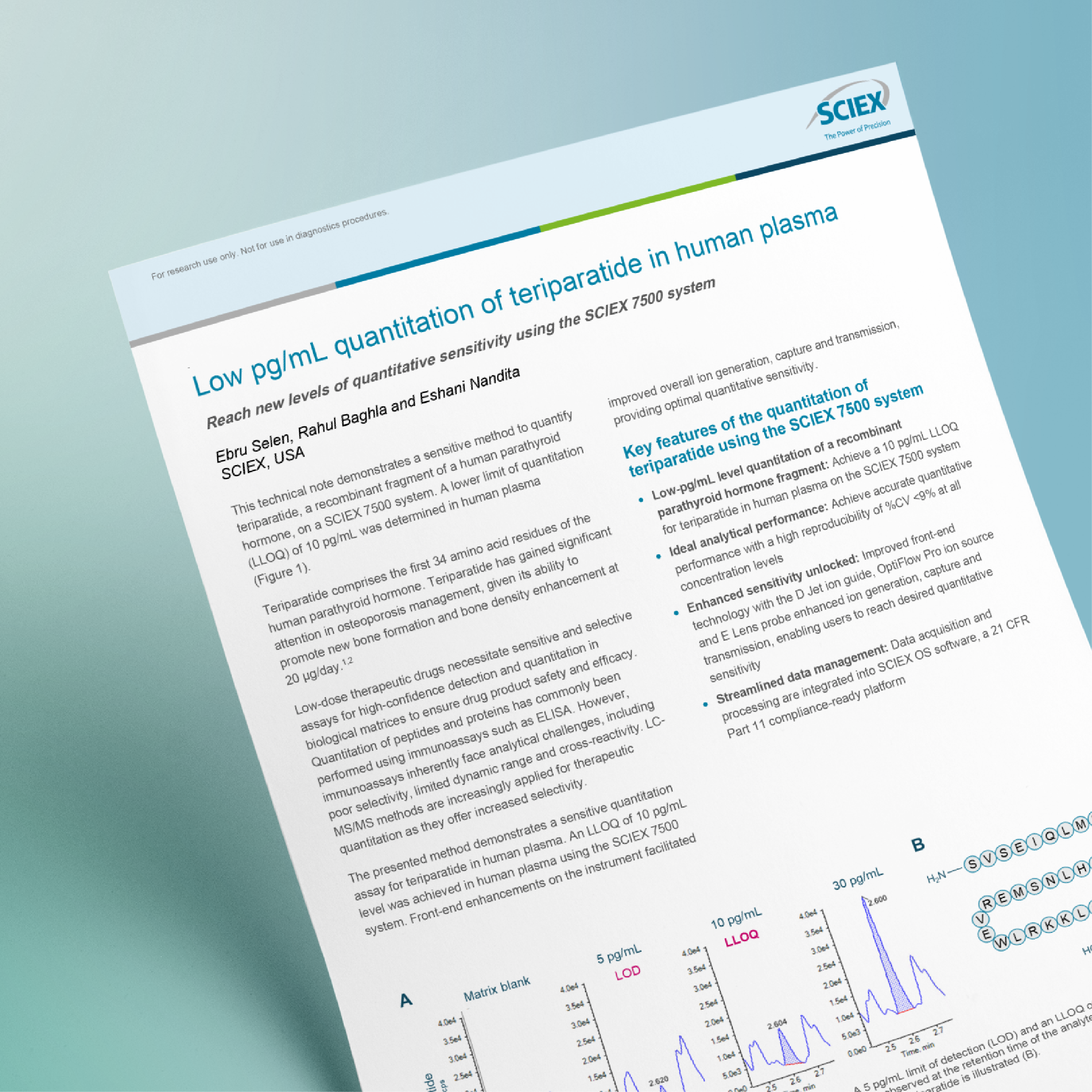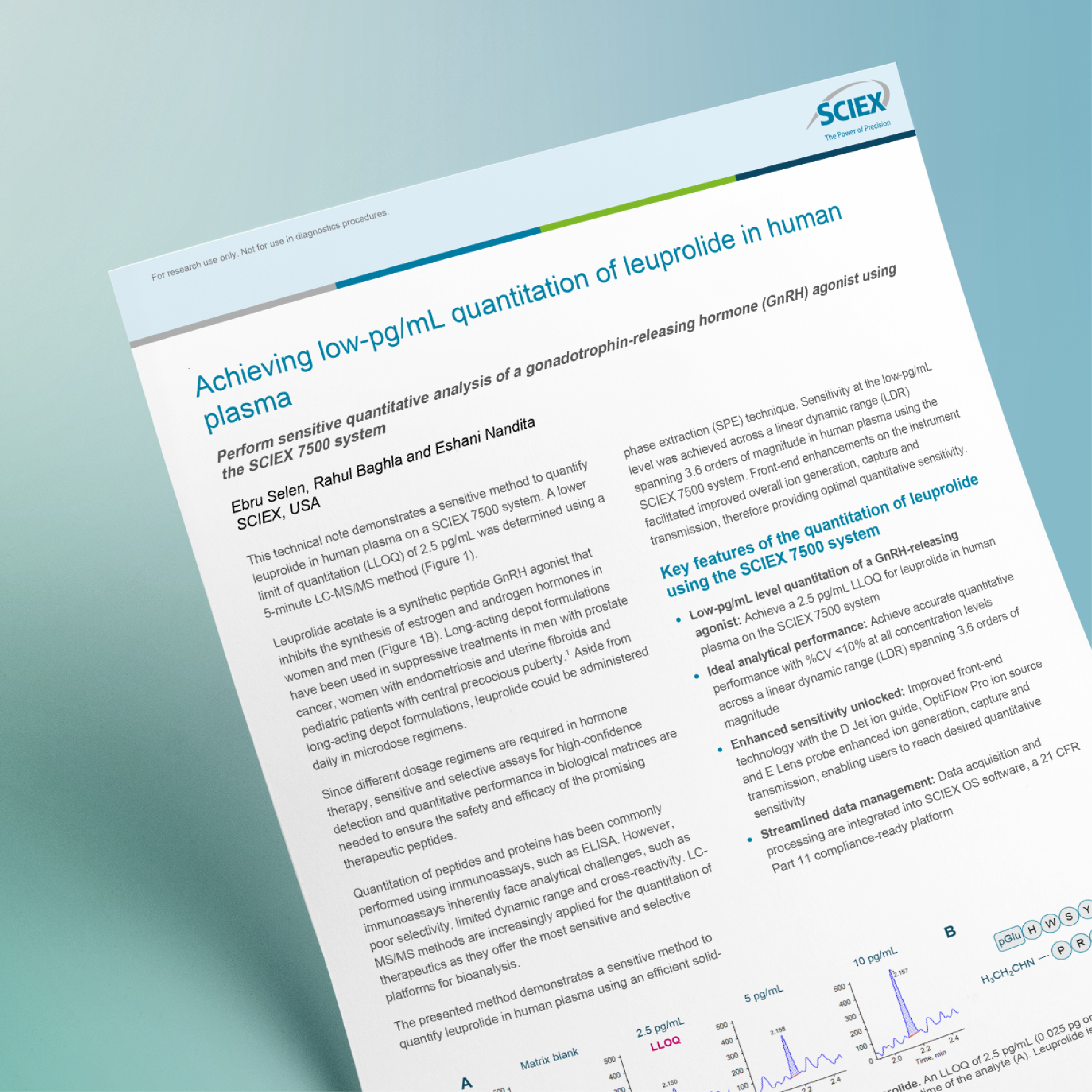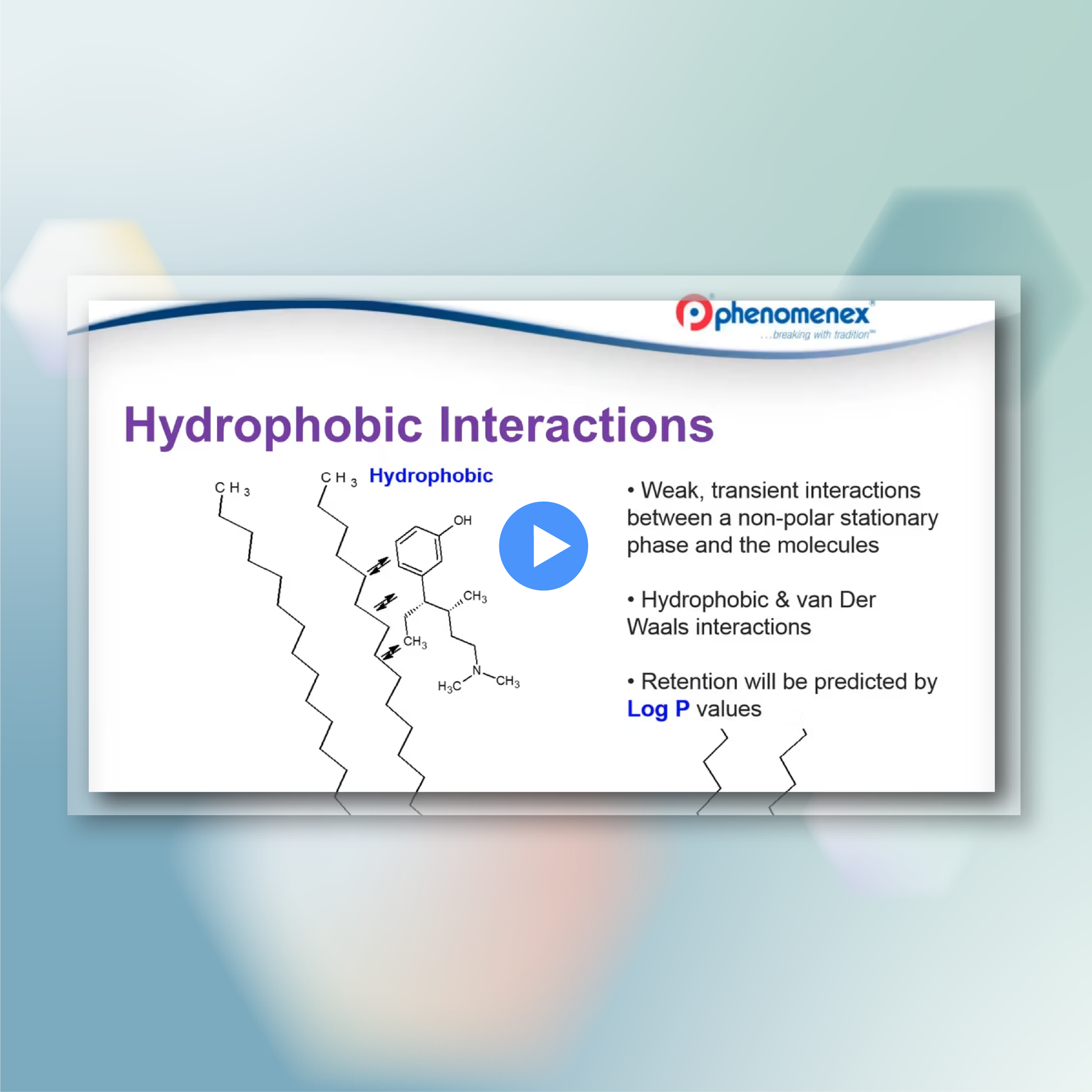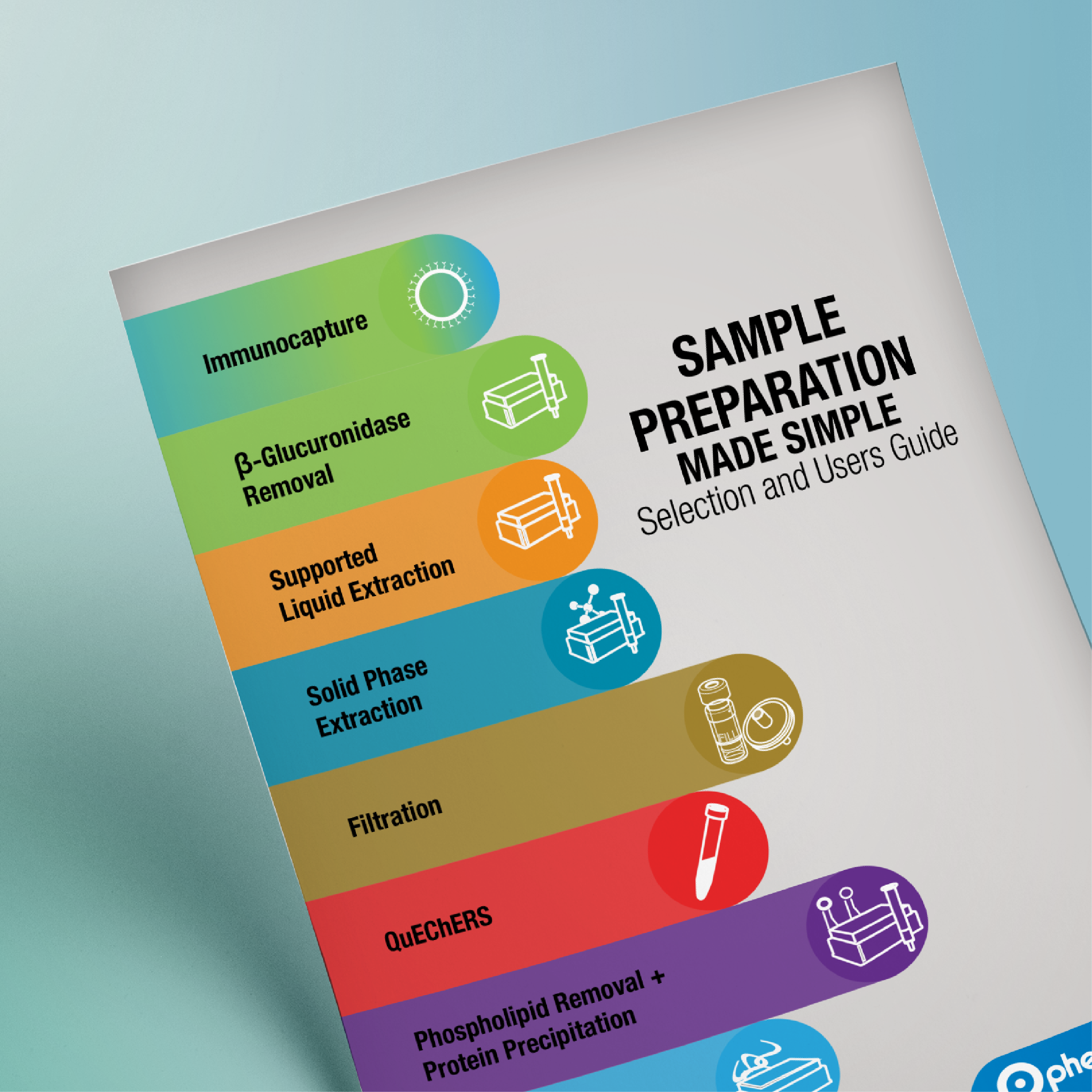Click on your subject of interest to jump to that section
 Biomarkers
Biomarkers
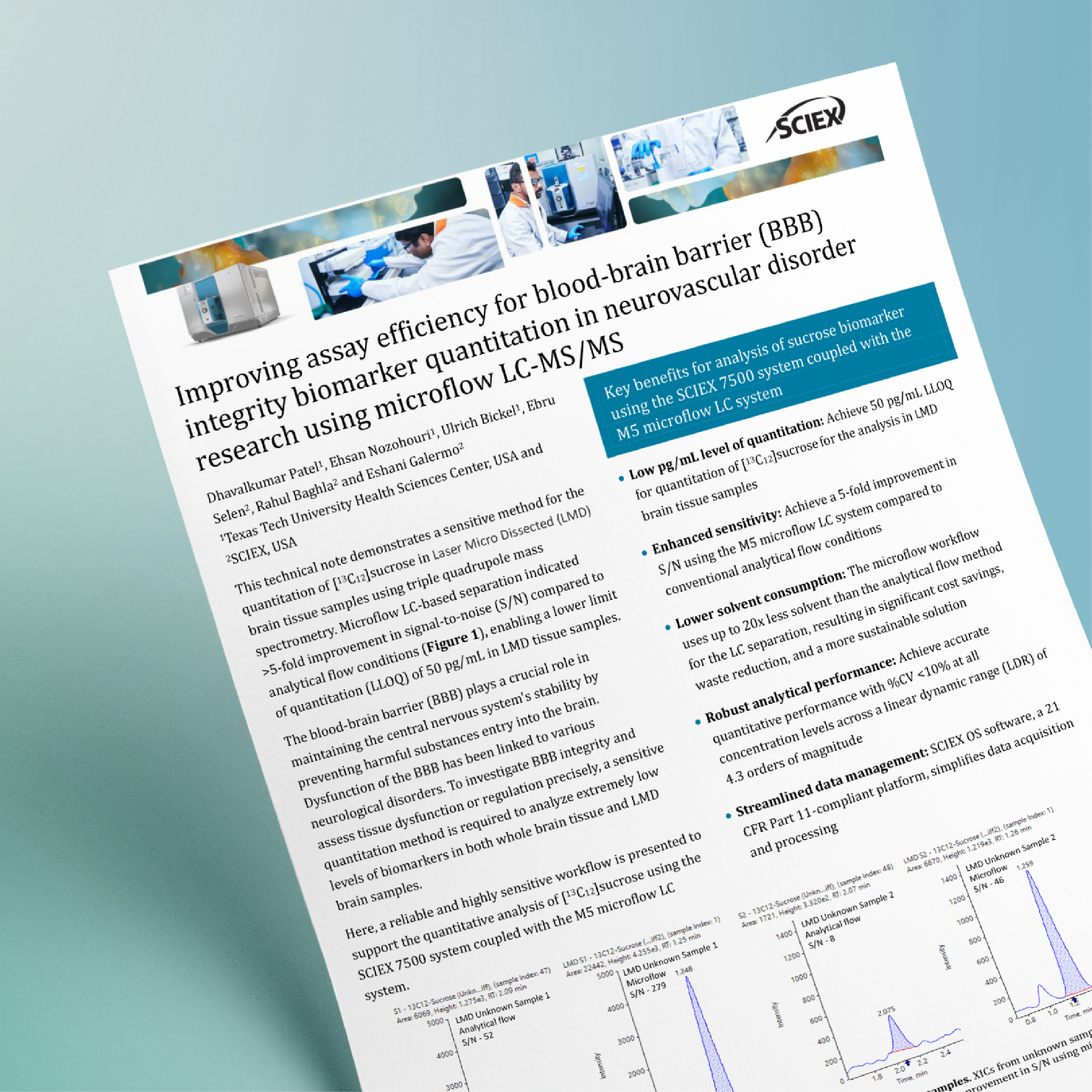
Assay efficiency for BBB integrity biomarker quantitation in neurovascular disorder research
The blood-brain barrier (BBB) plays a crucial role in maintaining the central nervous system's stability by preventing harmful substances entry into the brain. Dysfunction of the BBB has been linked to various neurological disorders. To investigate BBB integrity and assess tissue dysfunction or regulation precisely, a sensitive quantitation method is required to analyze extremely low levels of biomarkers in both whole brain tissue and LMD brain samples.
Here, a reliable and highly sensitive workflow is presented to support the quantitative analysis of [13C12]sucrose using the SCIEX 7500 system coupled with the M5 microflow LC system.
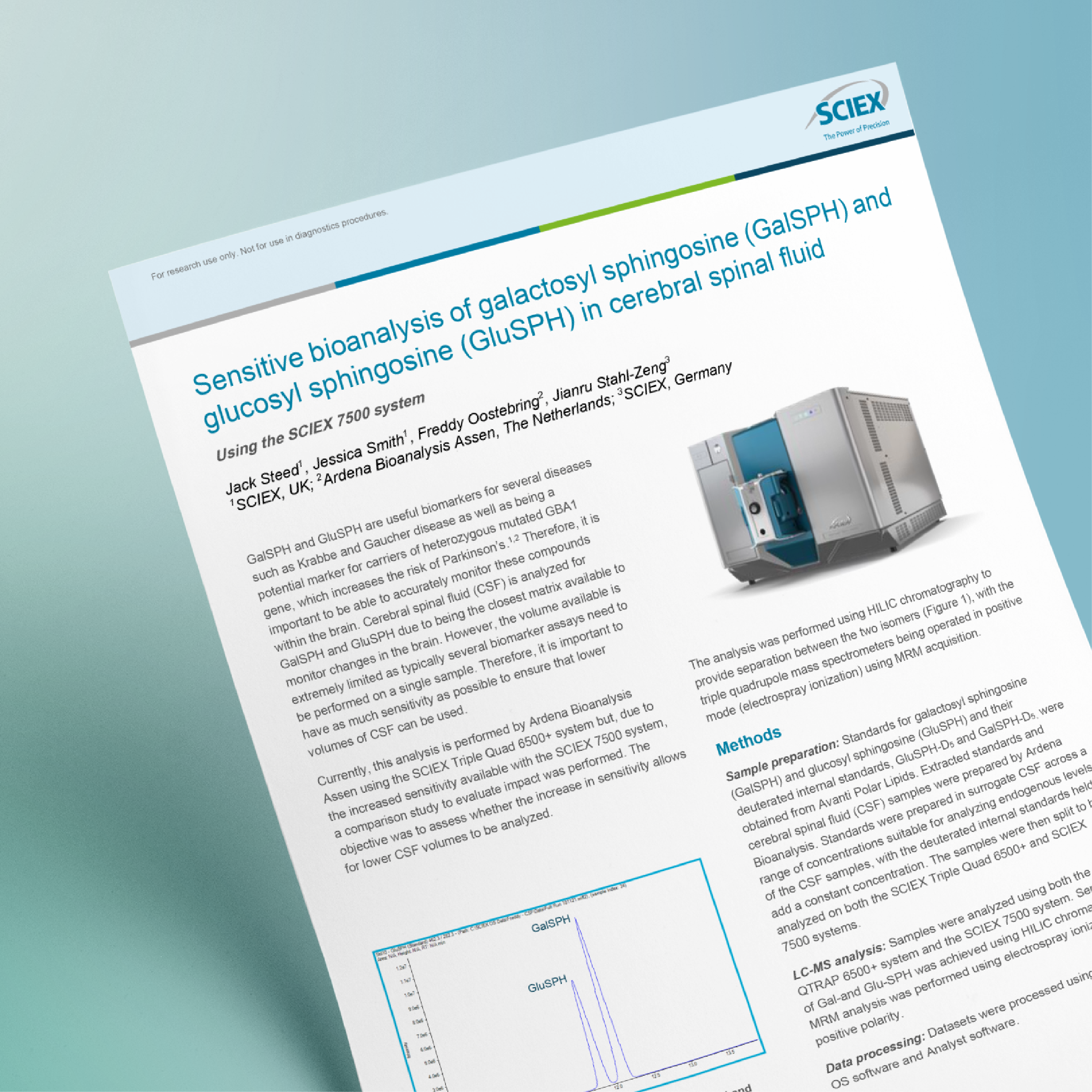
Surfactant protein markers quantified with an antibody-free platform
Sensitive bioanalysis of galactosyl sphingosine (GalSPH) and glucosyl sphingosine (GluSPH) in cerebral spinal fluid
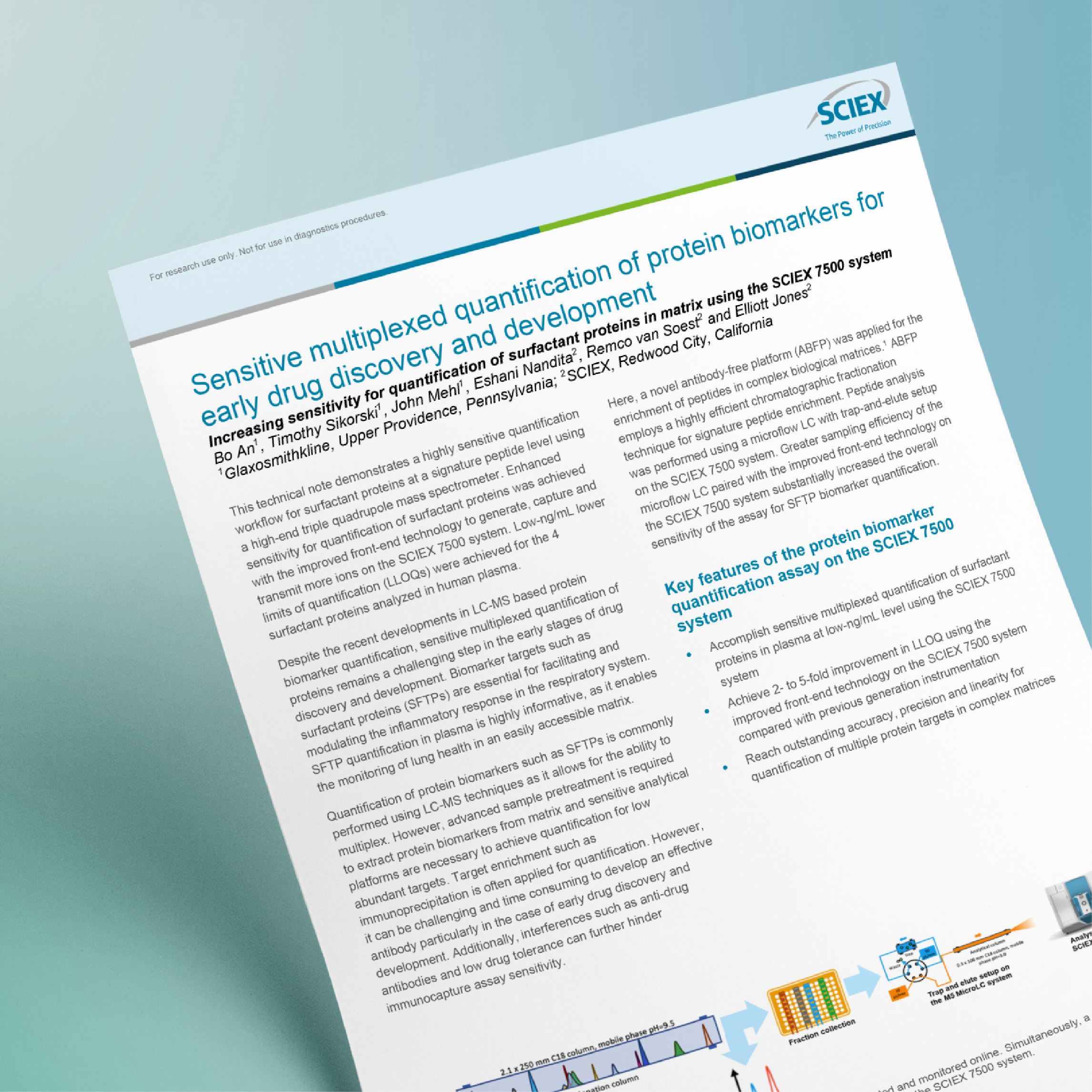
Quantified CSF markers for lysosomal storage disease
Sensitive multiplexed quantitation of protein biomarkers for early drug discovery and development. Low-ng/mL LLOQs were achieved for the 4 surfactant proteins analyzed in human plasma
 Biotherapeutics
Biotherapeutics

mRNA development with quantitative expresion analysis
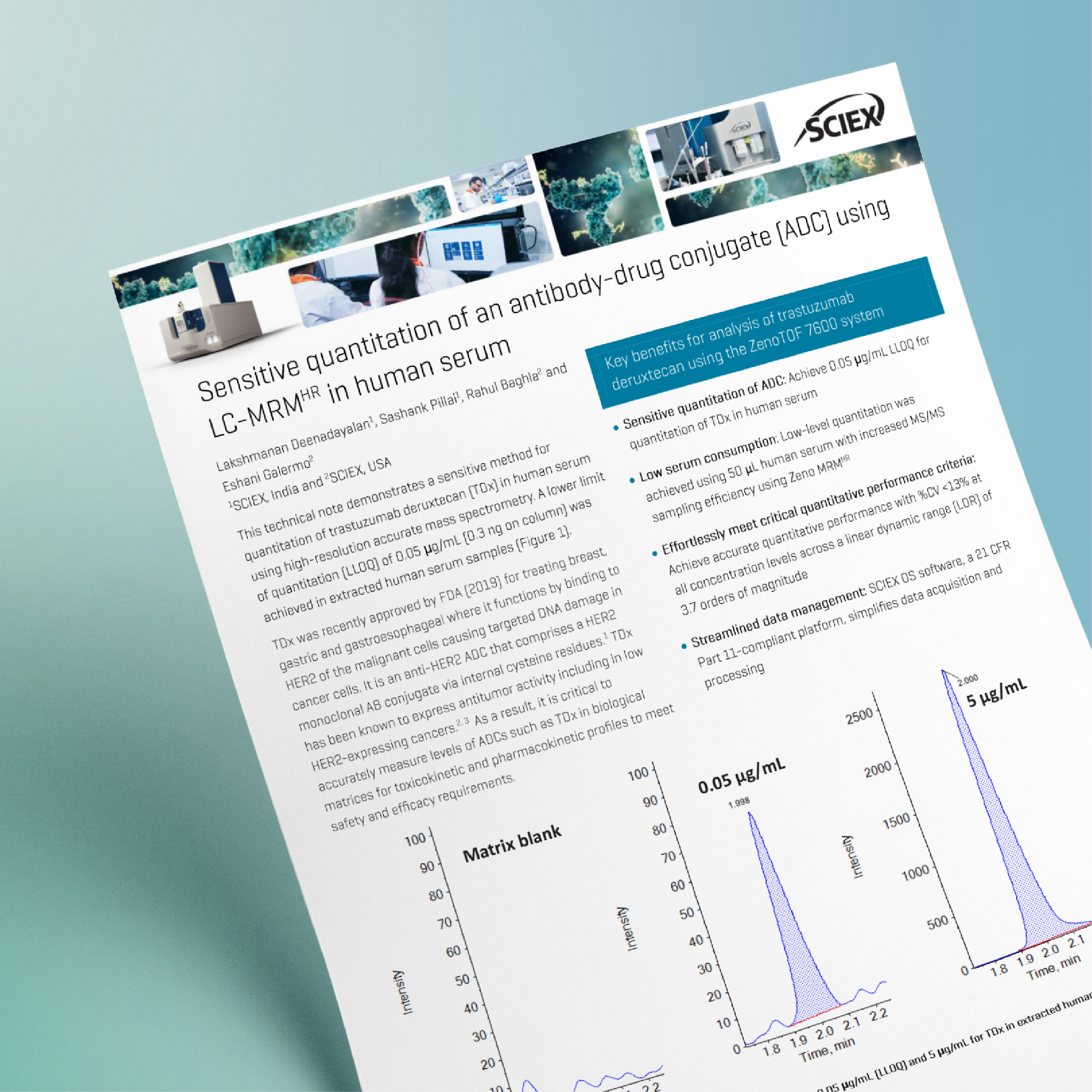
Sensitive quantitation of an ADC using LC-MRMHR in human serum
TDx was recently approved by FDA (2019) for treating breast, gastric and gastroesophageal where it functions by binding to HER2 of the malignant cells causing targeted DNA damage in cancer cells. It is an anti-HER2 ADC that comprises a HER2 monoclonal AB conjugate via internal cysteine residues.1 TDx has been known to express antitumor activity including in low HER2-expressing cancers. As a result, it is critical to accurately measure levels of ADCs such as TDx in biological matrices for toxicokinetic and pharmacokinetic profiles to meet safety and efficacy requirements.
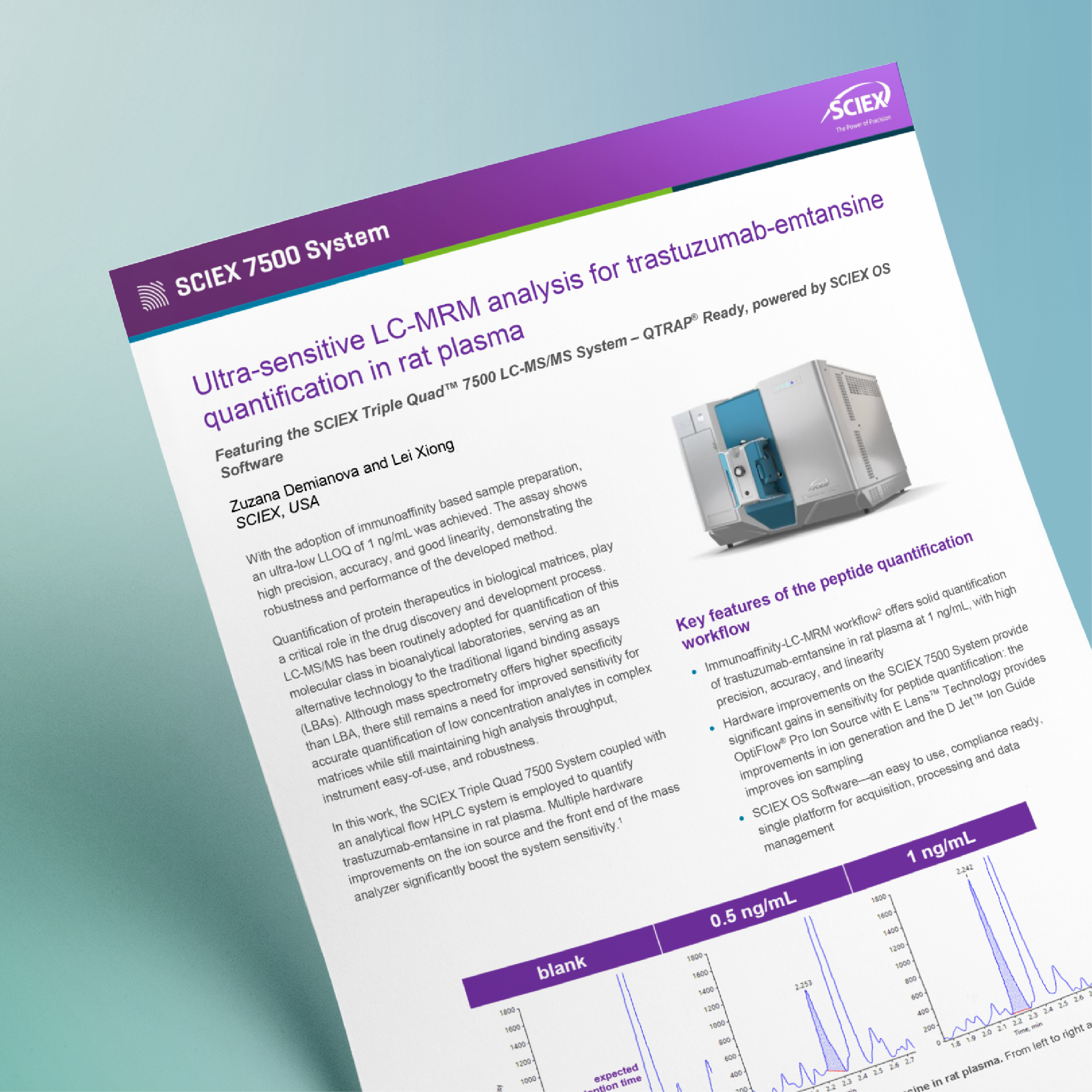
Immunoaffinity-LC-MRM quantitation of ADCs
Ultra-sensitive LC-MRM analysis for trastuzumab-emtansine quantitation in rat plasma
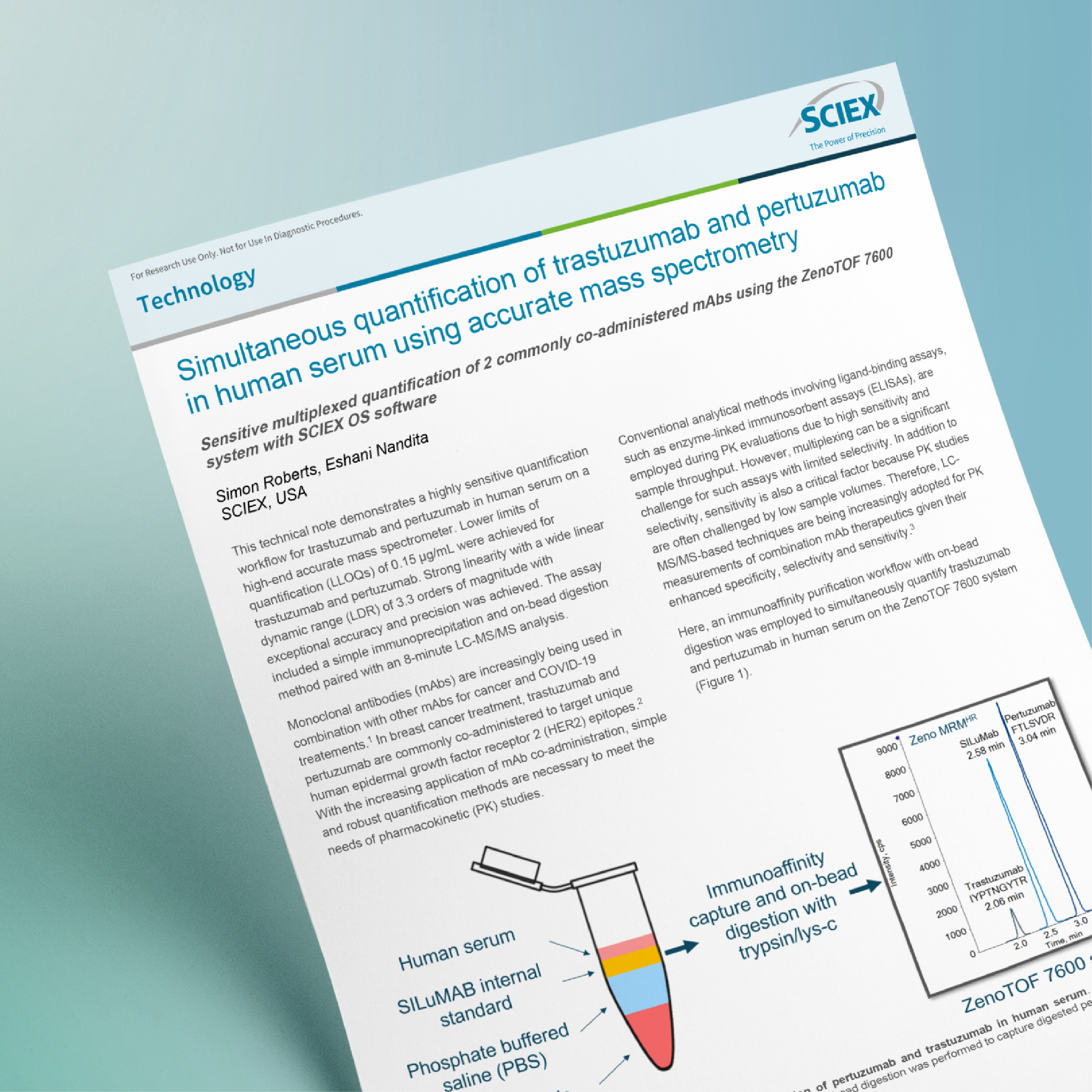
Quantifying combination mAb therapeutics with multiplexed accurate mass LC-MS/MS
Simultaneous quantitation of trastuzumab and pertuzumab in human serum using accurate mass spectrometry achieved LLOQs of 0.15 μg/mL and strong linearity, with a wide linear dynamic range (LDR) of 3.3 orders of magnitude
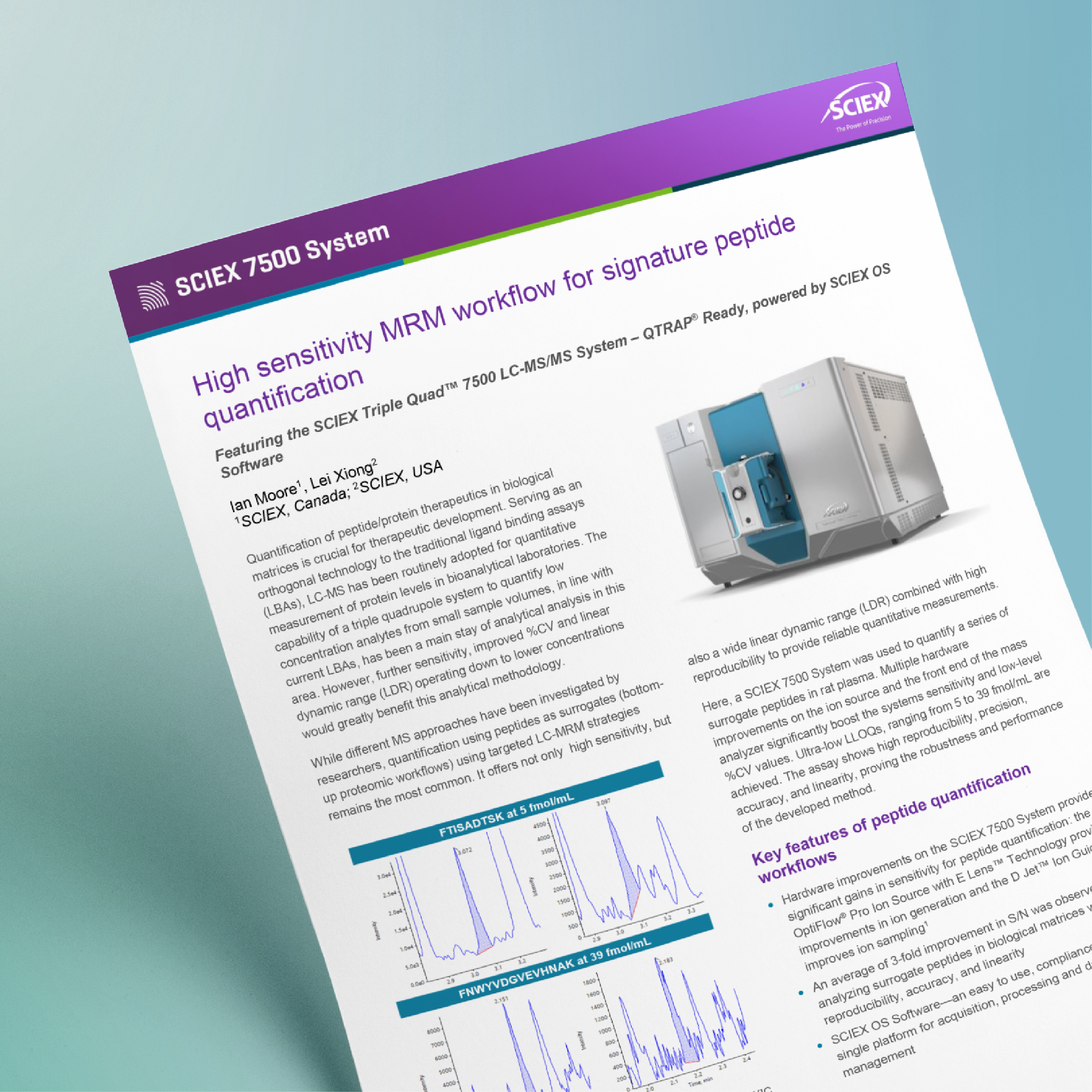
High sensitivity MRM workflow for signature peptide quantitation
A new method for increased sensitivity in peptide quantitation is used on a series of surrogate peptides in rat plasma. Ultra-low LLOQs ranging from 5 to 39 fmol/mL are achieved with the SCIEX 7500 system
 Cyclic peptides
Cyclic peptides
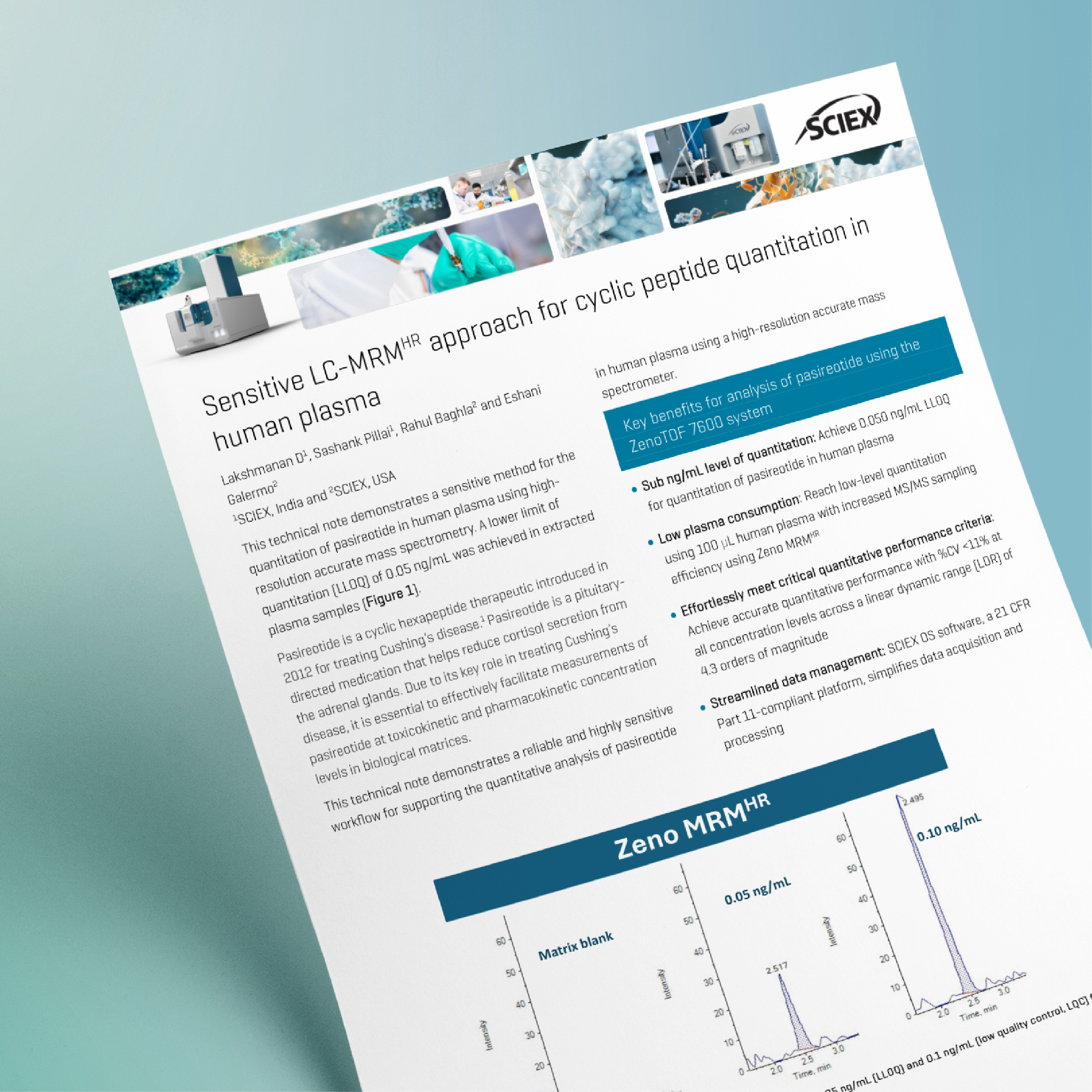
Sensitive LC-MRMHR approach for cyclic peptide quantitation in human plasma
This technical note demonstrates a reliable and highly sensitive workflow for supporting the quantitative analysis of pasireotide in human plasma using a high-resolution accurate mass spectrometer.
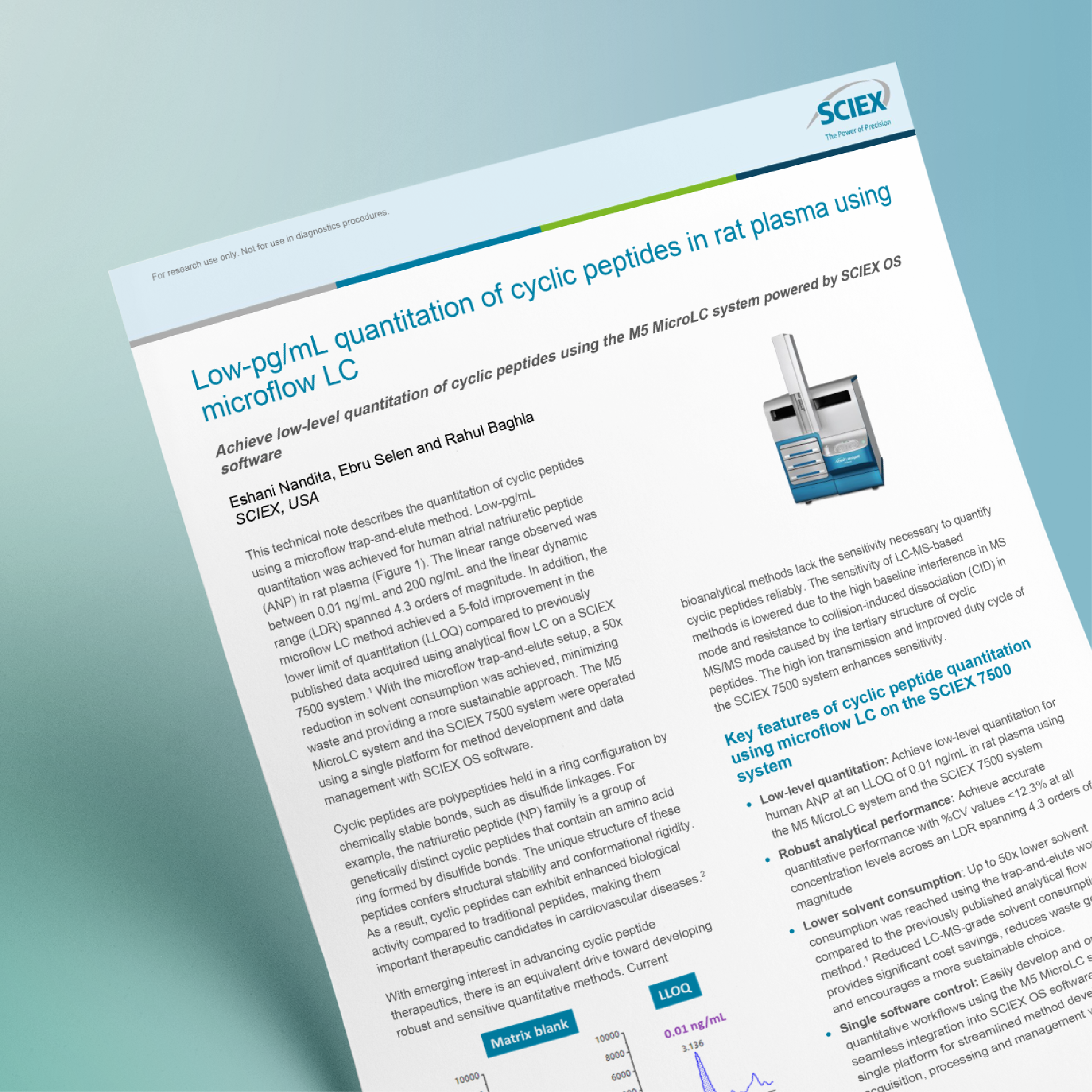
Low-level quantitation of cyclic peptides using the M5 microLC system
Cyclic peptide quantitation using a microflow trap-and-elute method. Low-pg/mL quantitation was achieved for human atrial natriuretic peptide (ANP) in rat plasma
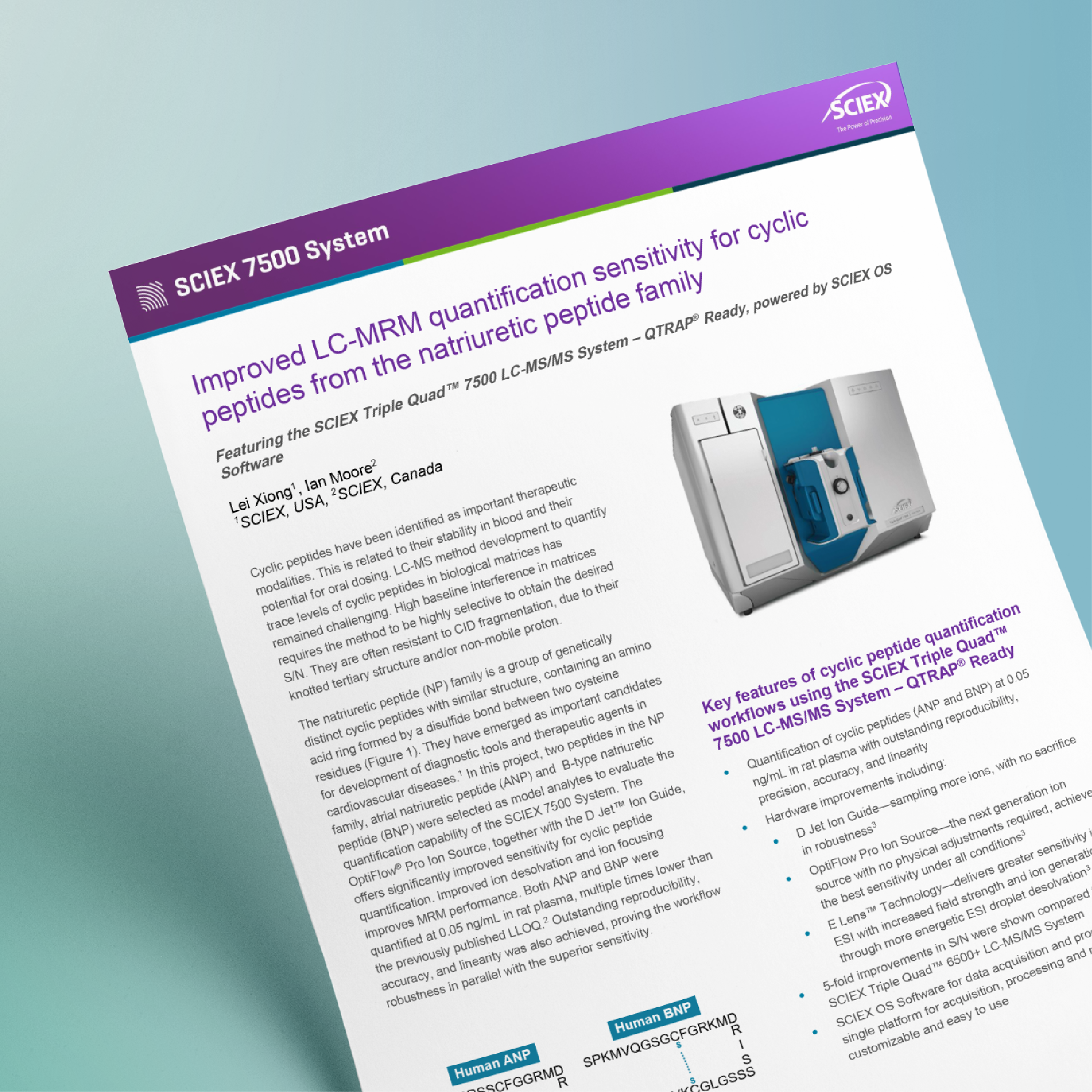
Improved LC-MRM quantitation sensitivity of cyclic peptides (ANP and NP)
Improved LC-MRM quantitation sensitivity for cyclic peptides from the natriuretic peptide family

Low-pg/mL quantitation of cyclic peptides in rat plasma using microflow LC
The quantitation of cyclic peptides using a microflow trap-and-elute method
 HPAPI
HPAPI
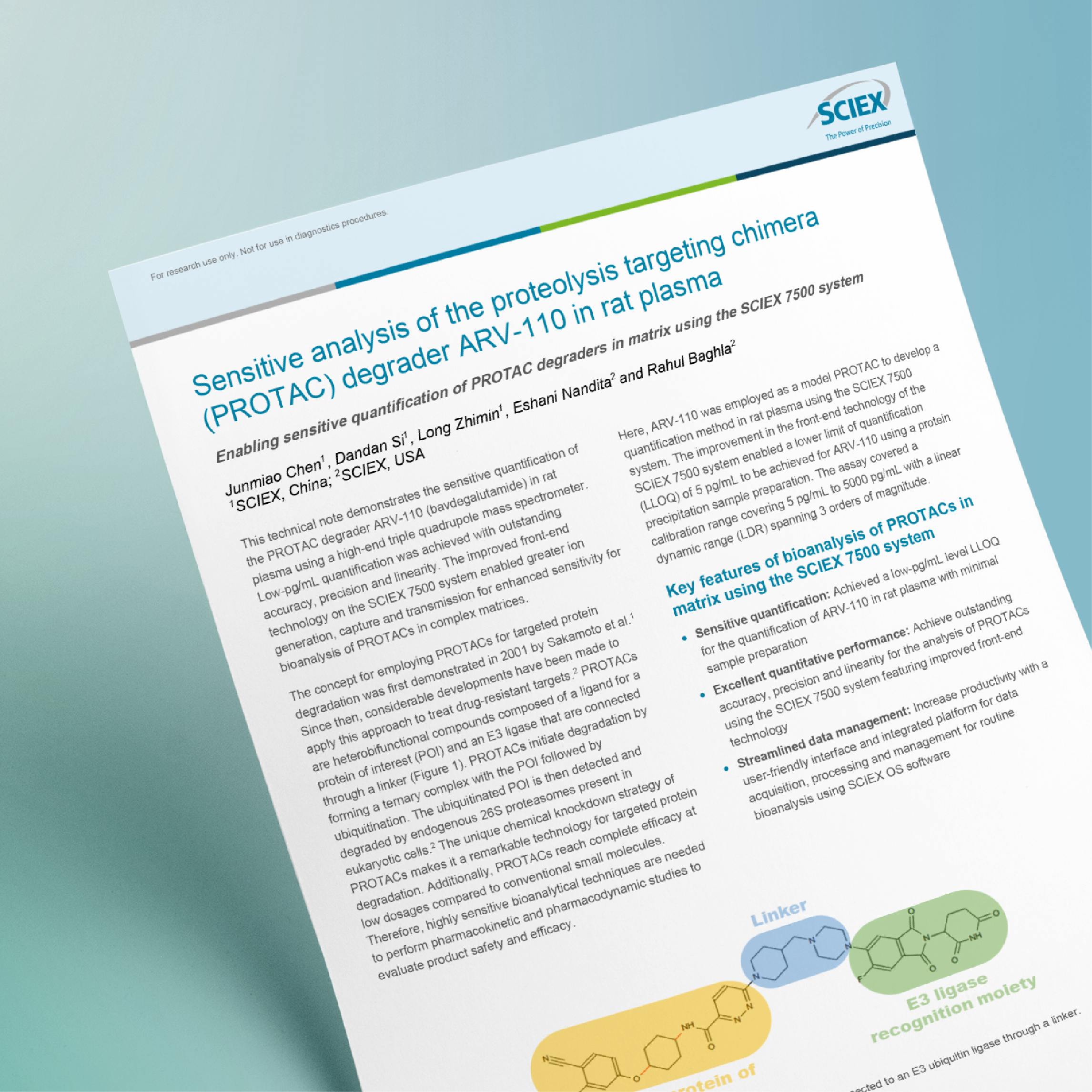
Sensitive quantitation of the PROTAC degrader ARV-110 in rat plasma
Sensitive analysis of the proteolysis targeting chimera (PROTAC) degrader ARV-110 in rat plasma
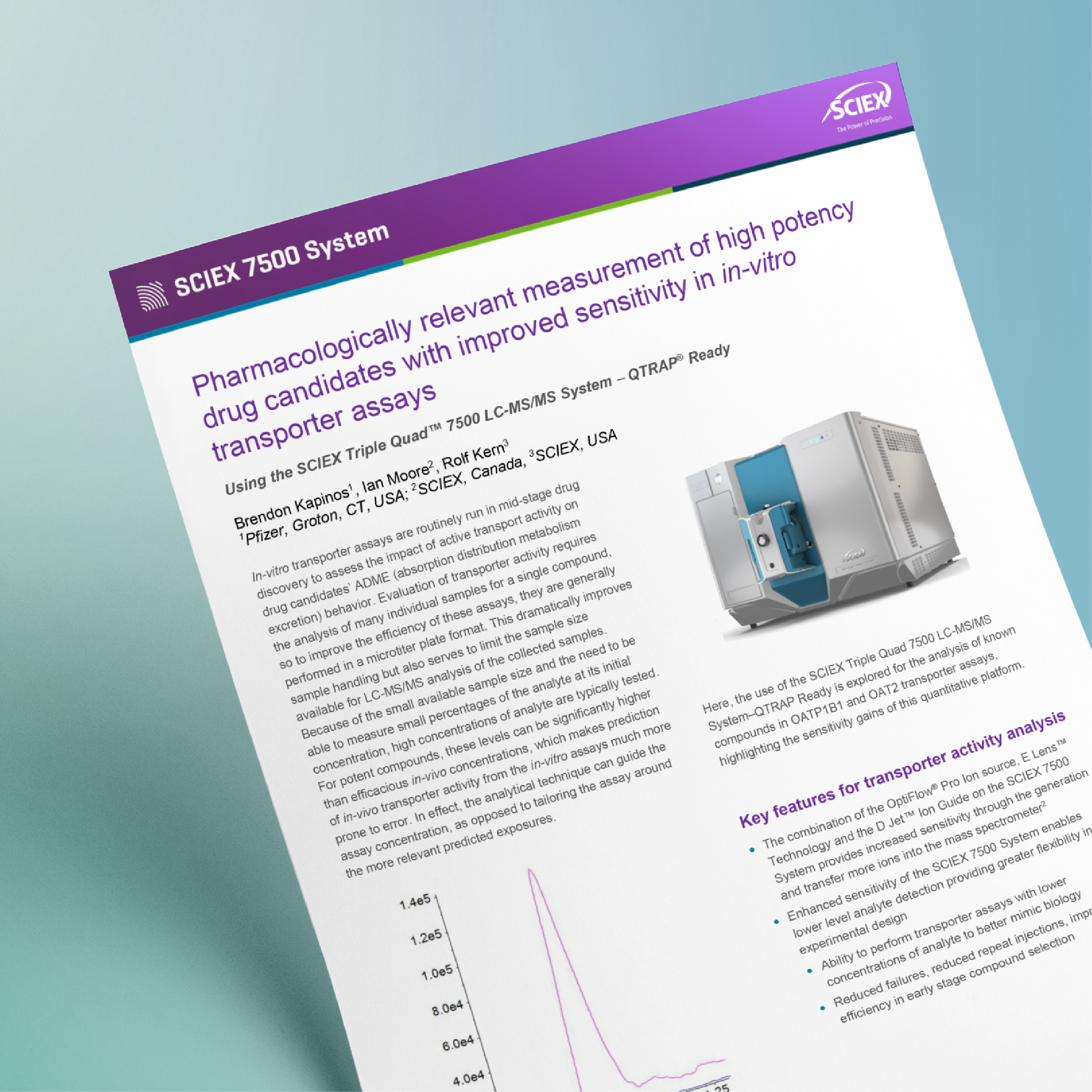
High potency drug candidates with improved sensitivity in in-vitro transporter assays
Use of lower compound concentration in transporter assays results in more accurate data that can guide early stage drug development
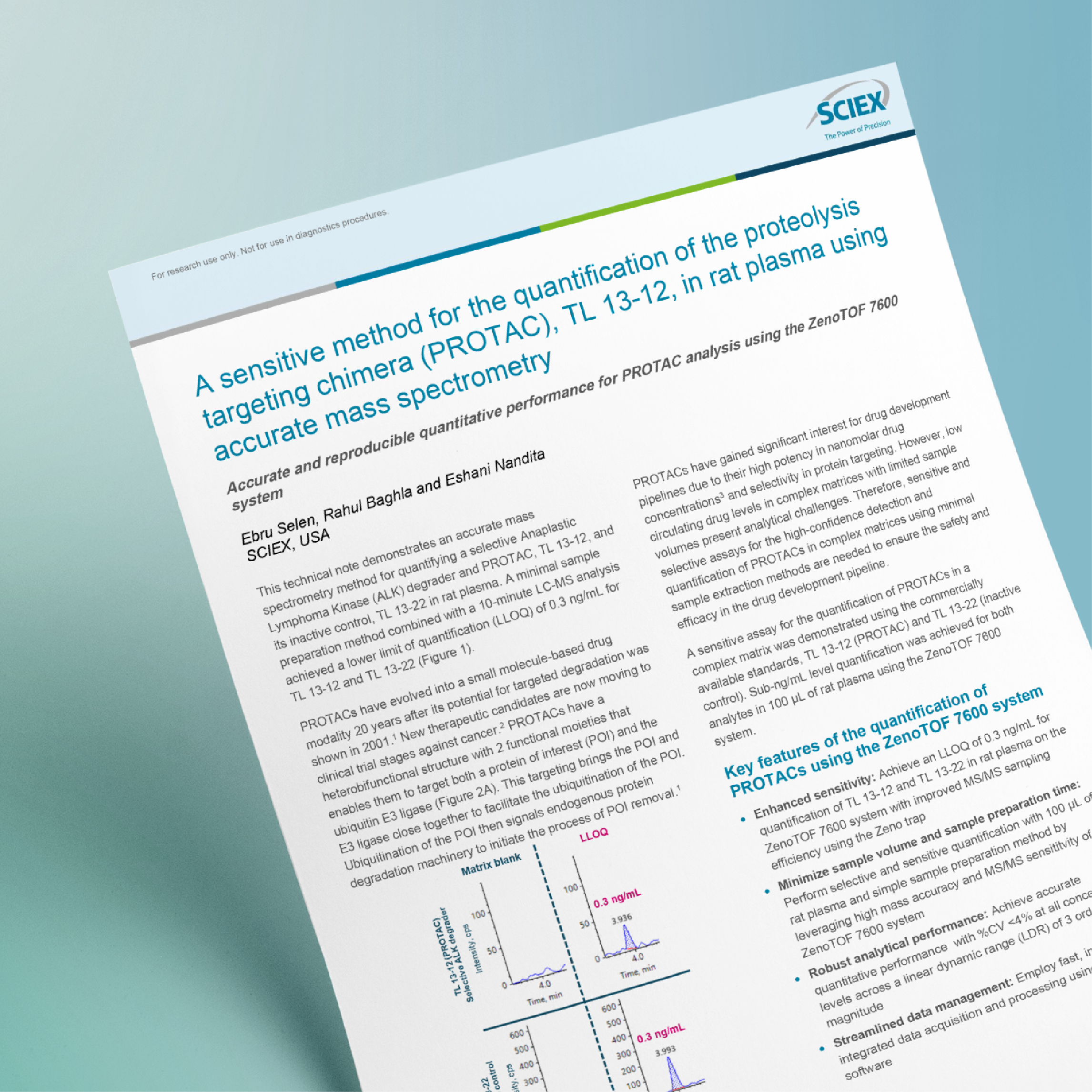
Low pg/mL quantitation of TL 13-112, a protein targeting chimera (PROTAC) in rat plasma
Highly sensitive, robust, rapid workflow to quantify TL 13-112 and its inactive control, TL 13-110, in rat plasma
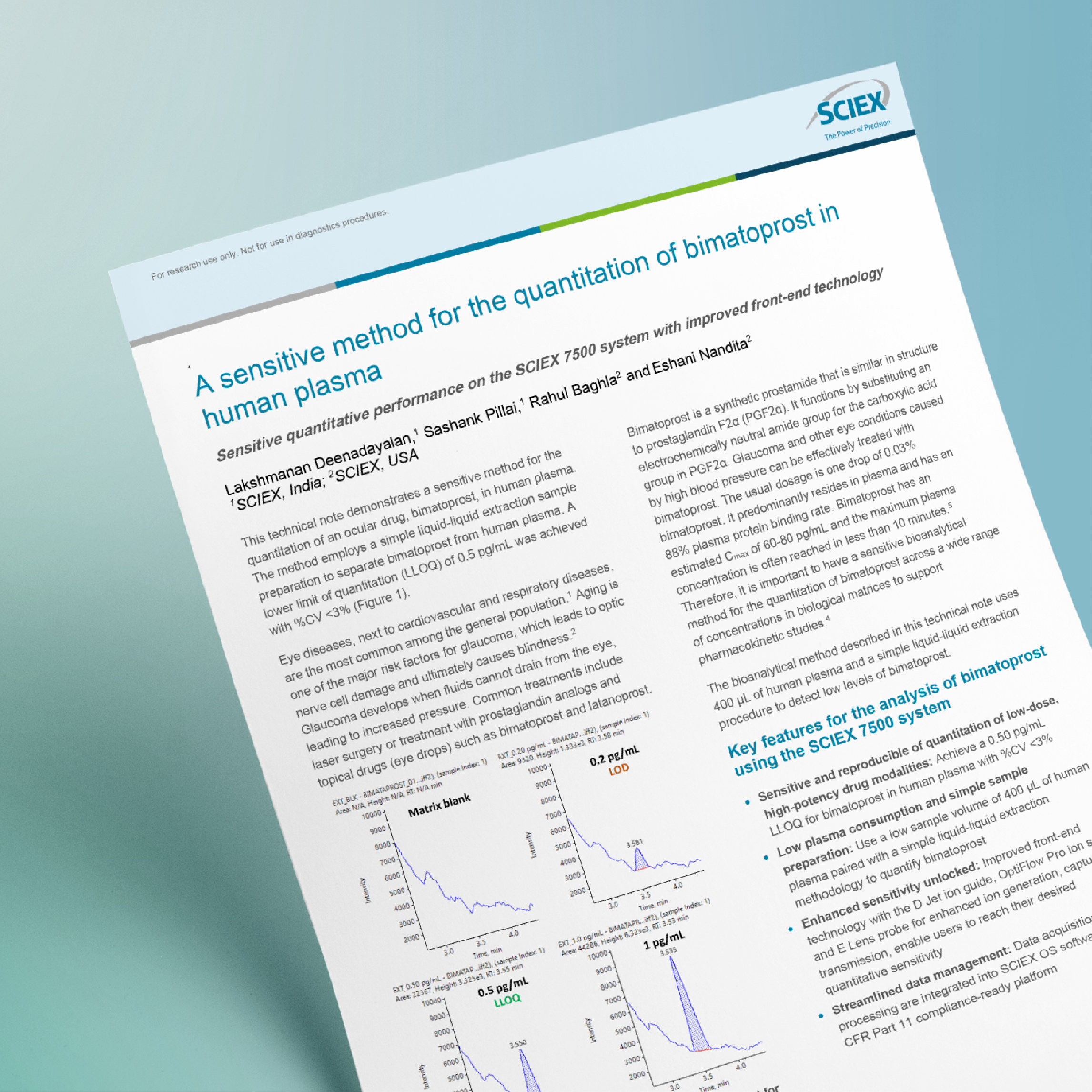
A sensitive method for the quantitation of bimatoprost in human plasma
A sensitive method for the quantitation of bimatoprost in human plasma

Next-level sensitivity for the quantitation of warfarin and furosemide in human plasma
Sensitive quantitation of small molecule pharmaceutical compounds, extracted from human plasma, using minimal sample preparation and negative ion mode-based analysis
![]() Inhaled products
Inhaled products
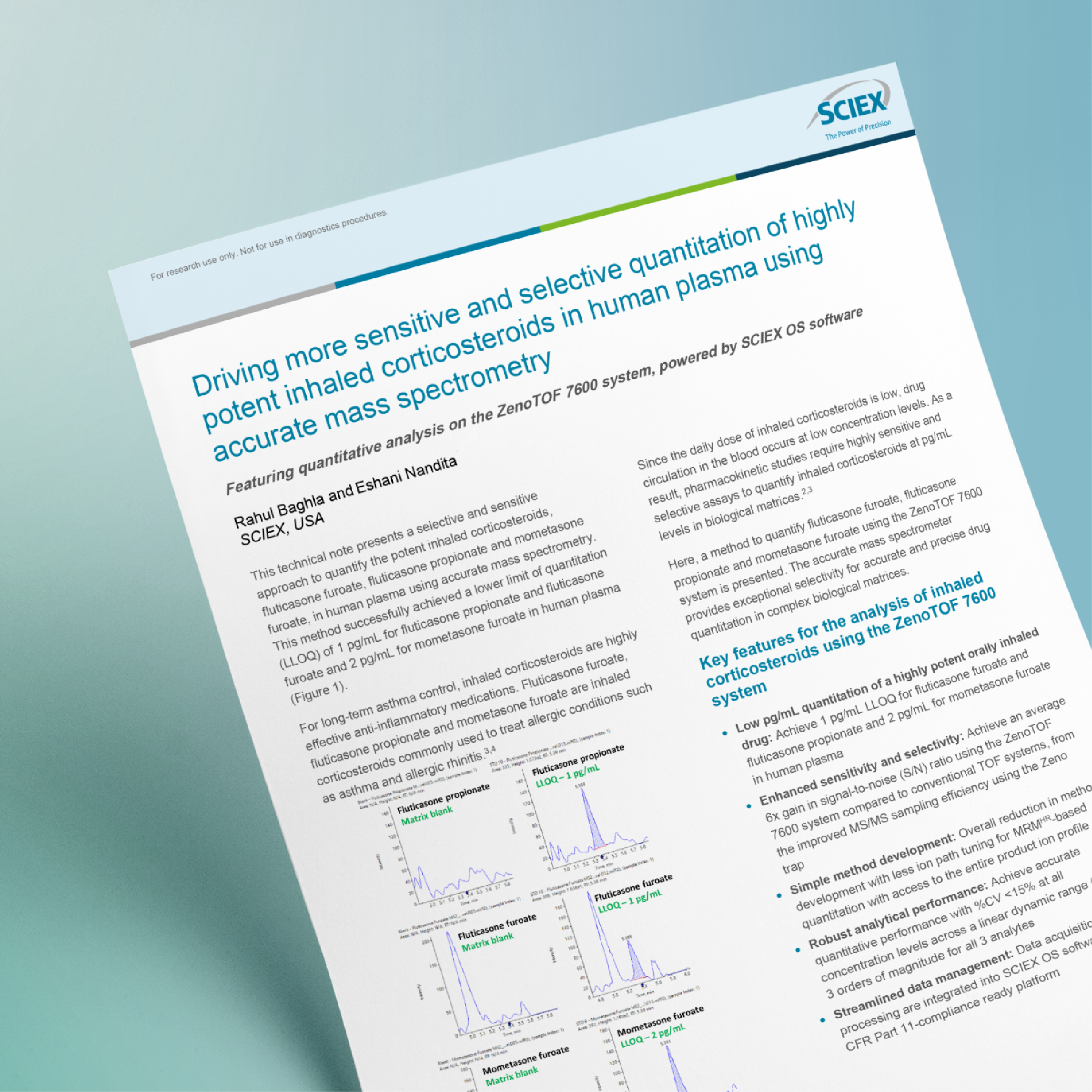
Driving more sensitive and selective quantitation of highly potent inhaled corticosteroids
This technical note presents a selective and sensitive approach to quantify the potent inhaled corticosteroids, fluticasone furoate, fluticasone propionate and mometasone furoate, in human plasma using accurate mass spectrometry. This method successfully achieved a lower limit of quantitation (LLOQ) of 1 pg/mL for fluticasone propionate and fluticasone furoate and 2 pg/mL for mometasone furoate in human plasma.
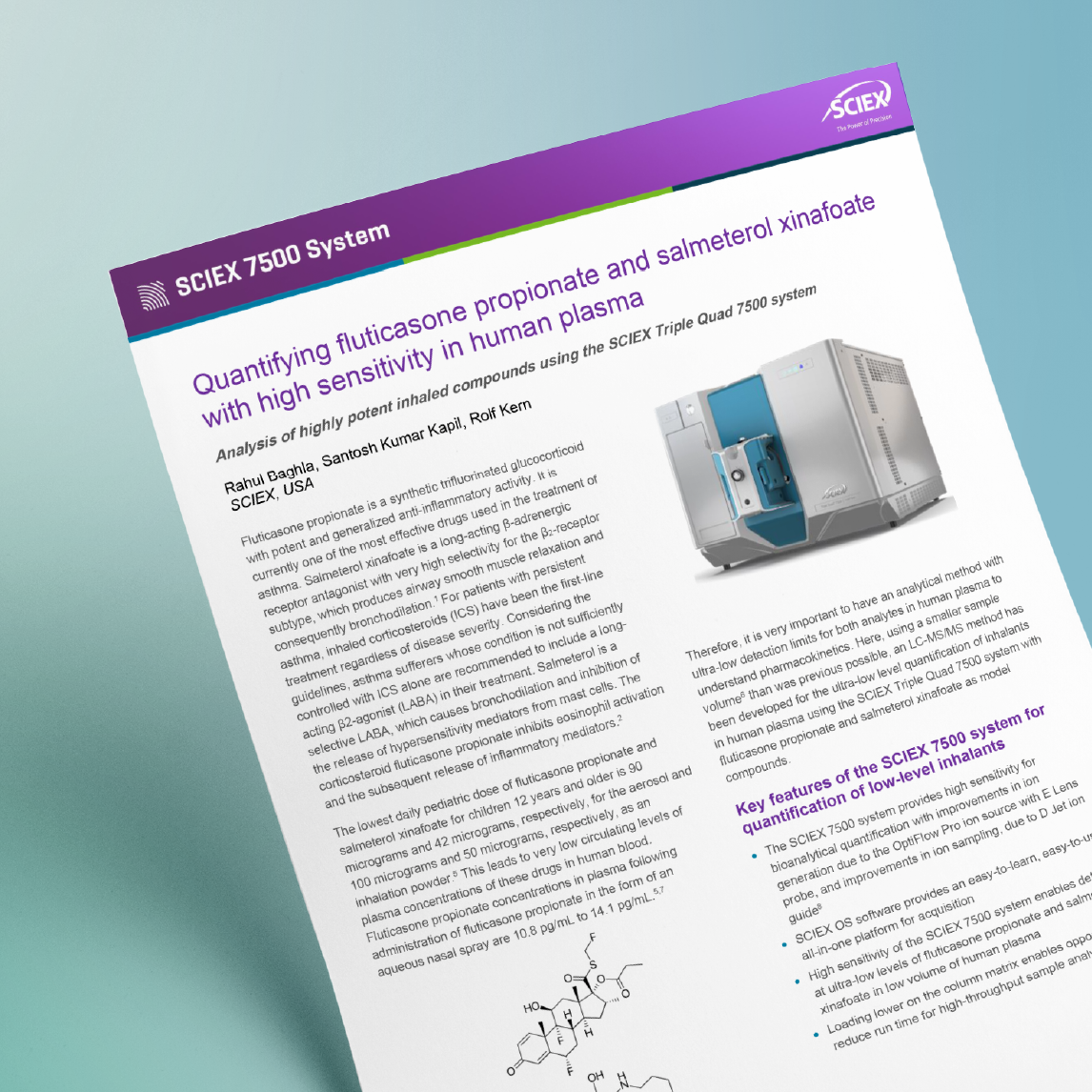
Routinely detect ultra-low levels of two highly potent inhaled compounds
Quantifying fluticasone propionate and salmeterol xinafoate with high sensitivity in human plasma
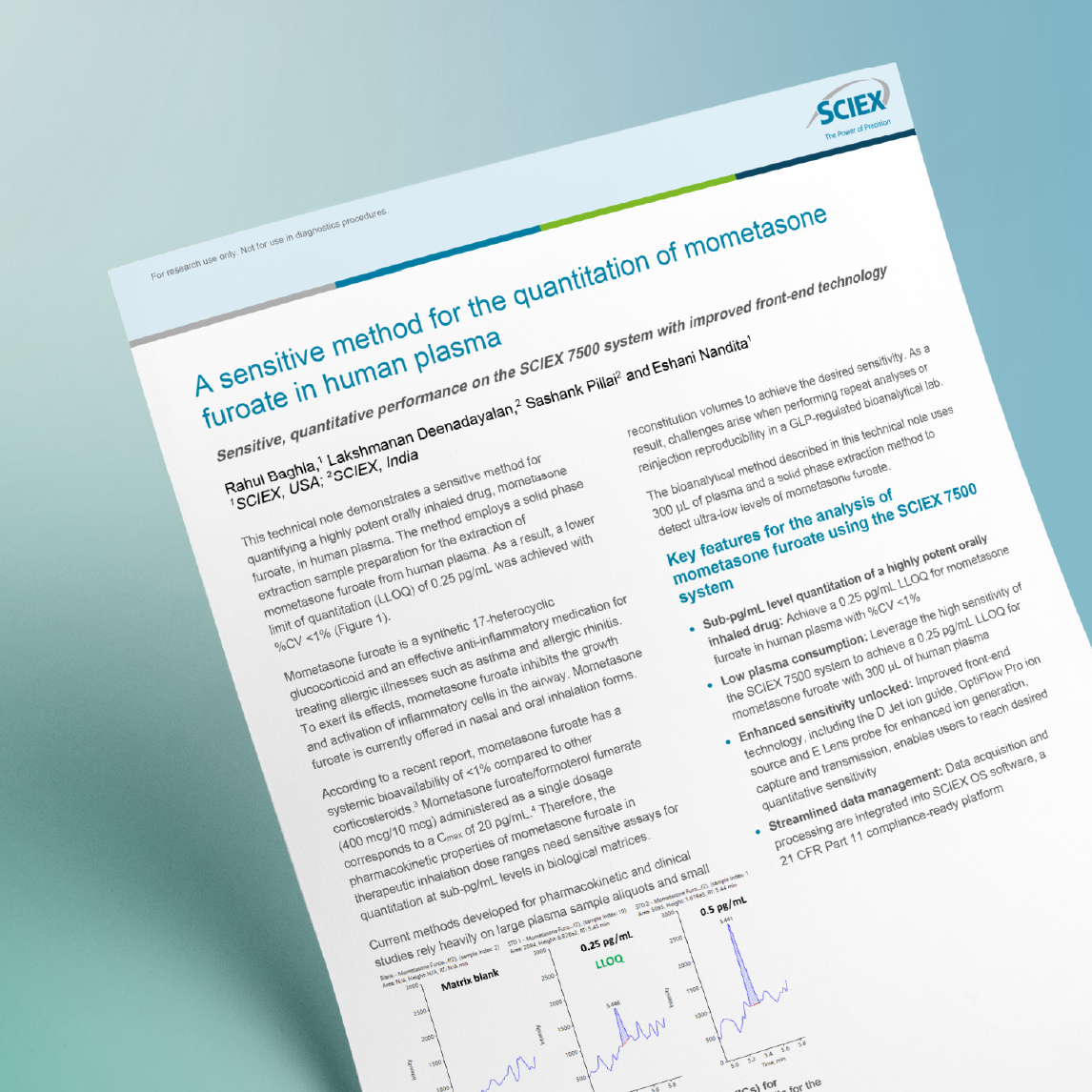
A sensitive method for the quantitation of mometasone furoate in human plasma
A sensitive method for quantifying a highly potent, orally inhaled drug, mometasone furoate, in human plasma
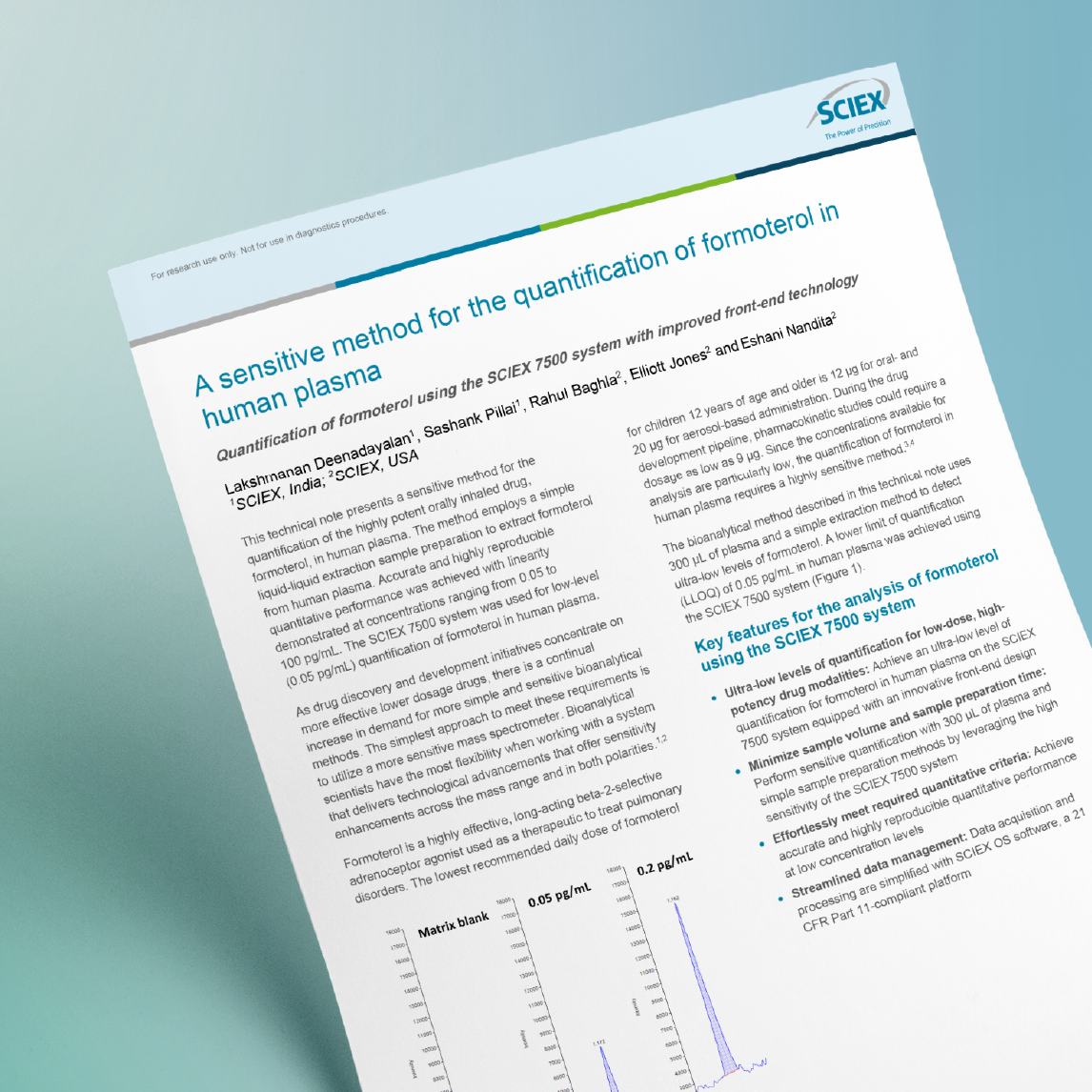
A sensitive method for the quantitation of formoterol in human plasma
A sensitive method for the quantitation of formoterol, in human plasma, employing a simple liquid-liquid extraction sample preparation
 Insulin and Insulin Analogs
Insulin and Insulin Analogs
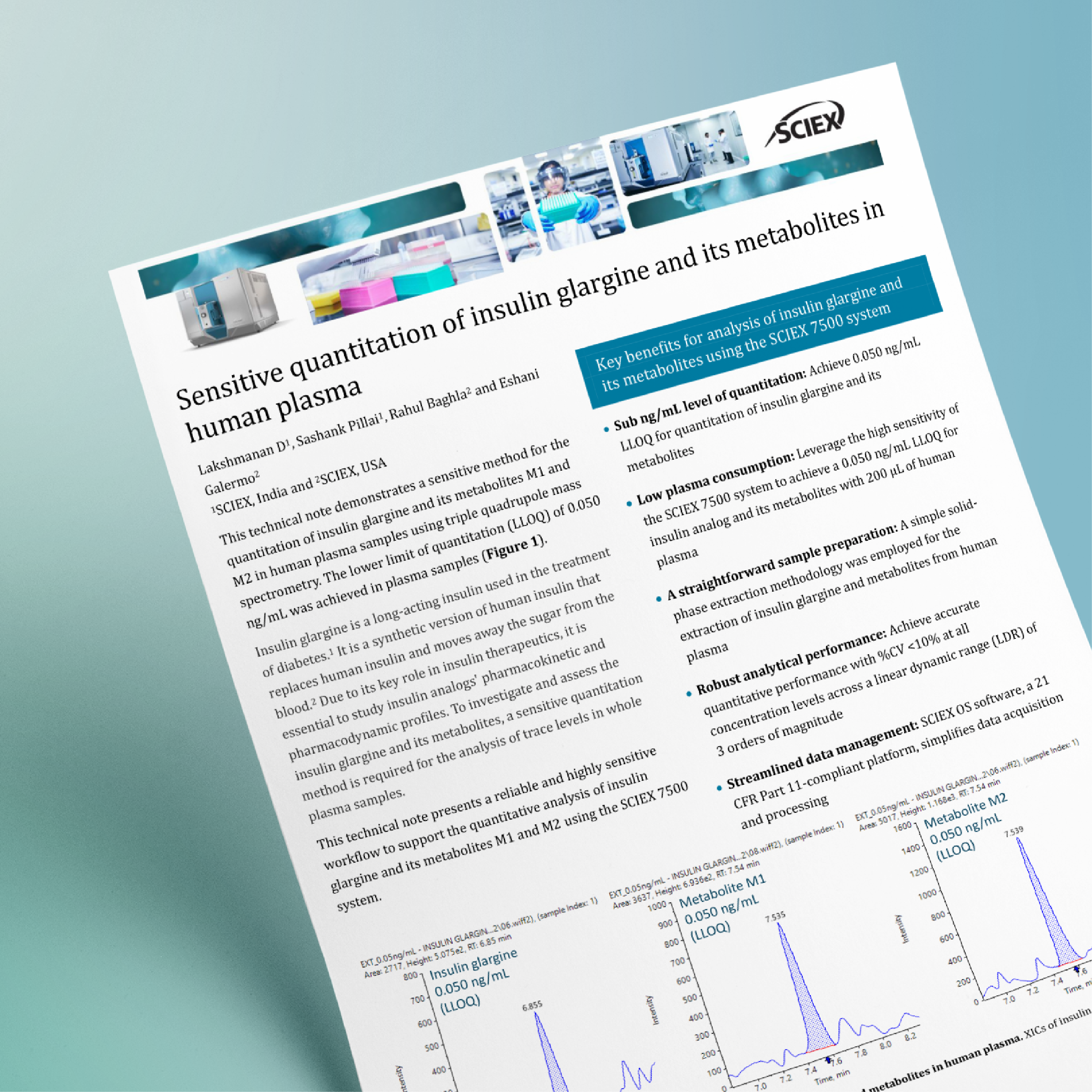
Sensitive quantitation of insulin glargine and its metabolites in human plasma
This technical note presents a reliable and highly sensitive workflow to support the quantitative analysis of insulin glargine and its metabolites M1 and M2 using the SCIEX 7500 system.

Quantitative analysis of IGF-1 and 2 by LC-MRM with scheduled ionization
Quantitation of human insulin-like growth factor-1 and 2 by MRM LC-MS/MS with scheduled ionization
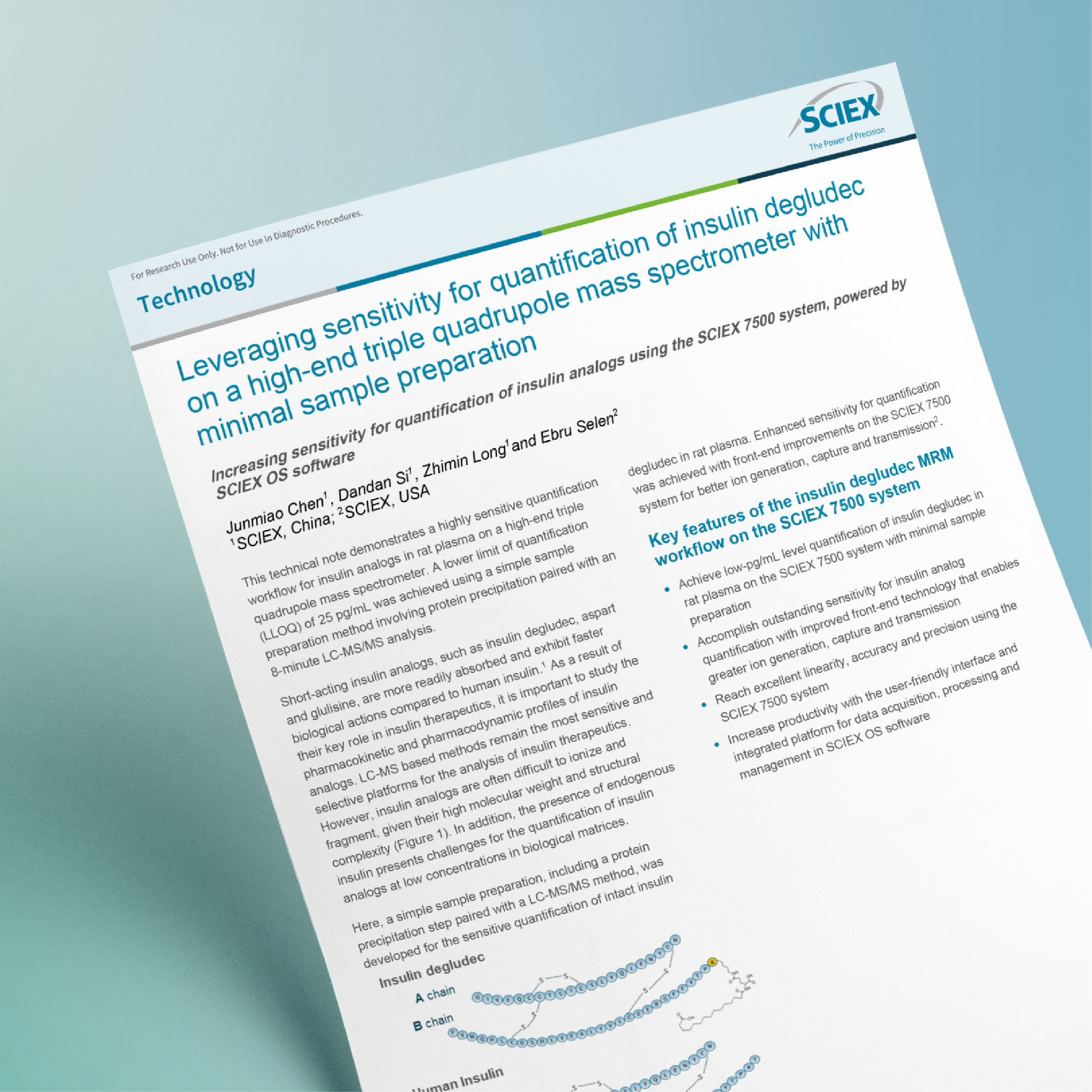
Highly sensitive quantitative workflow for insulin analogs with minimal sample prep
Using intact insulin degludec in rat plasma to demonstrate an LLOQ of 25 pg/mL, with simple protein precipitation sample preparation and an 8-minute LC-MS/MS analysis
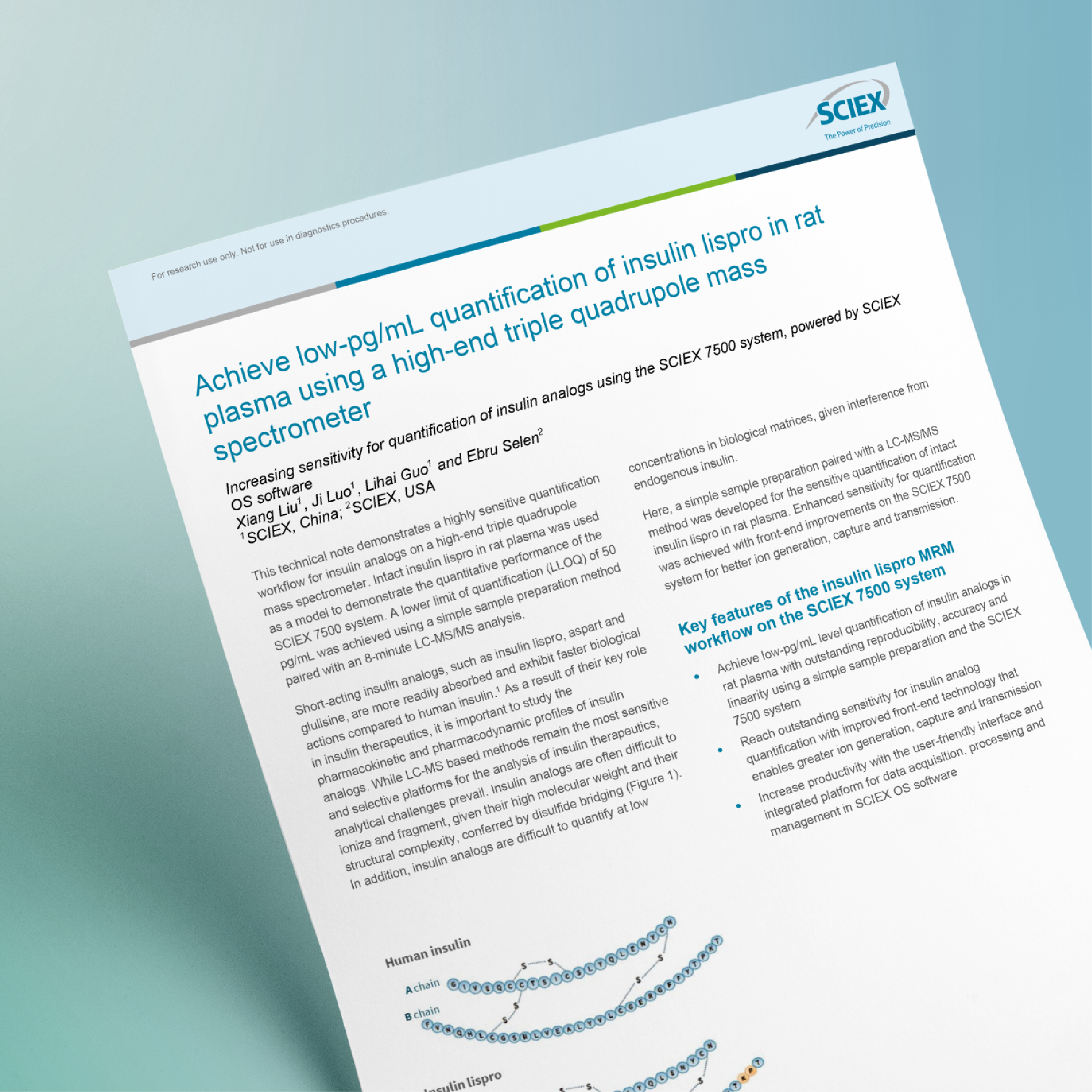
Achieve low-pg/mL level quantitation of insulin lispro in rat plasma
Using intact insulin lispro in rat plasma to demonstrate an LLOQ of 50 pg/mL, with simple sample preparation and an 8-minute LC-MS/MS analysis
 Oligonucleotides
Oligonucleotides
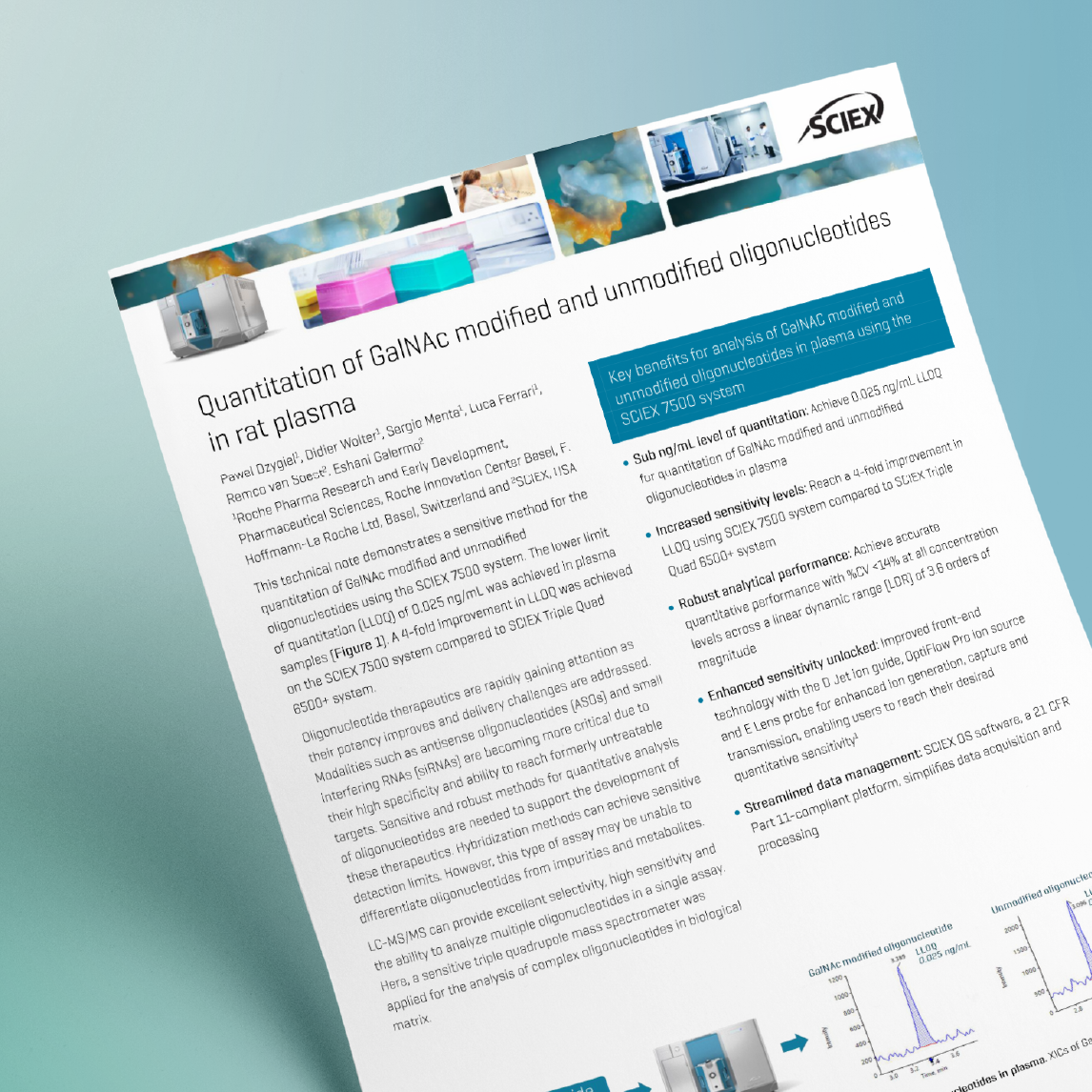
Quantitation of GalNAc modified and unmodified oligonucleotides in rat plasma
This technical note demonstrates a sensitive method for the quantitation of GalNAc modified and unmodified oligonucleotides using the SCIEX 7500 system. The lower limit of quantitation (LLOQ) of 0.025 ng/mL was achieved in plasma samples. A 4-fold improvement in LLOQ was achieved on the SCIEX 7500 system compared to SCIEX Triple Quad 6500+ system.
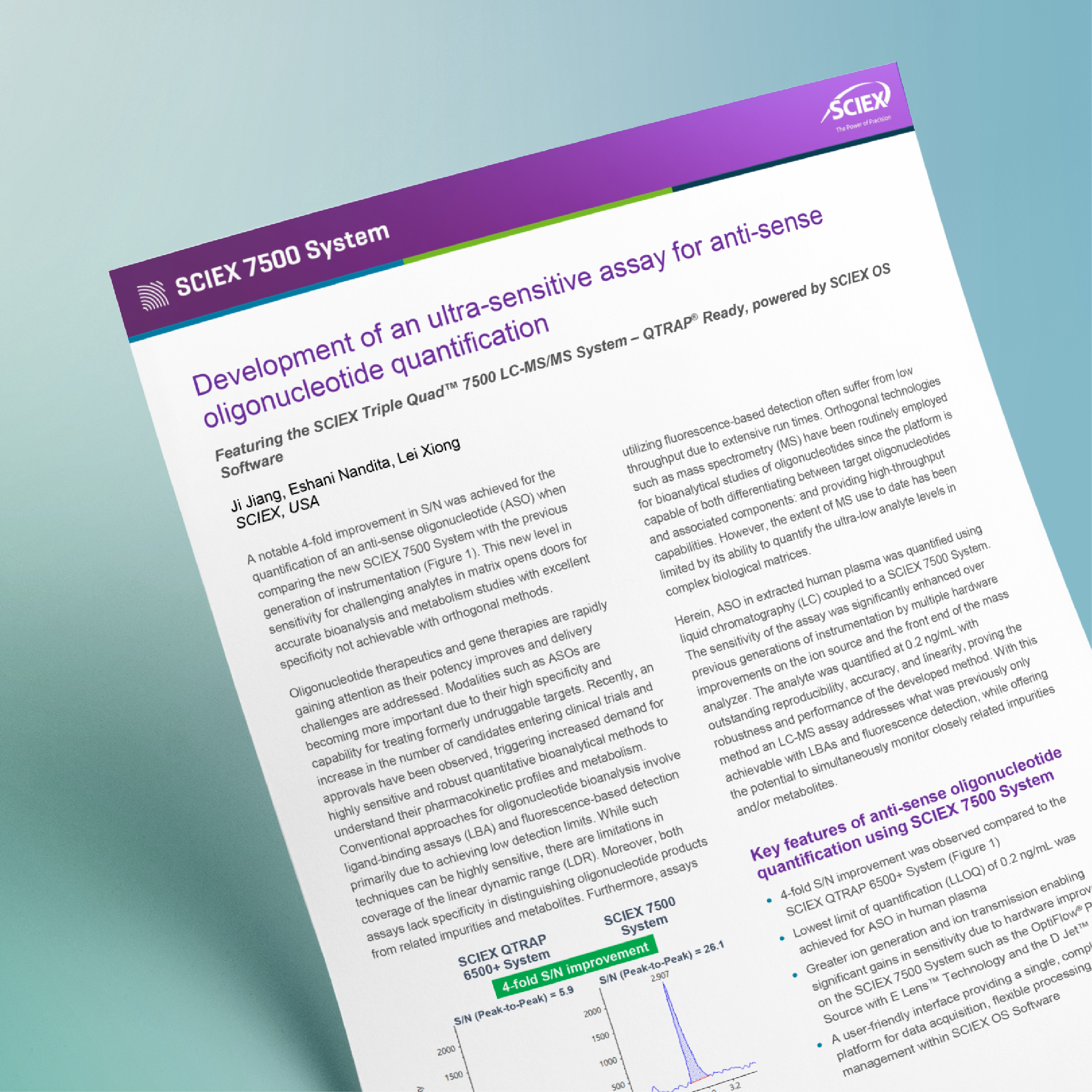
Ultra-high sensitivity for quantitation of ASO in human plasma
4-fold increase in S/N when quantifying an anti-sense oligonucleotide (ASO) with the new SCIEX 7500 system!
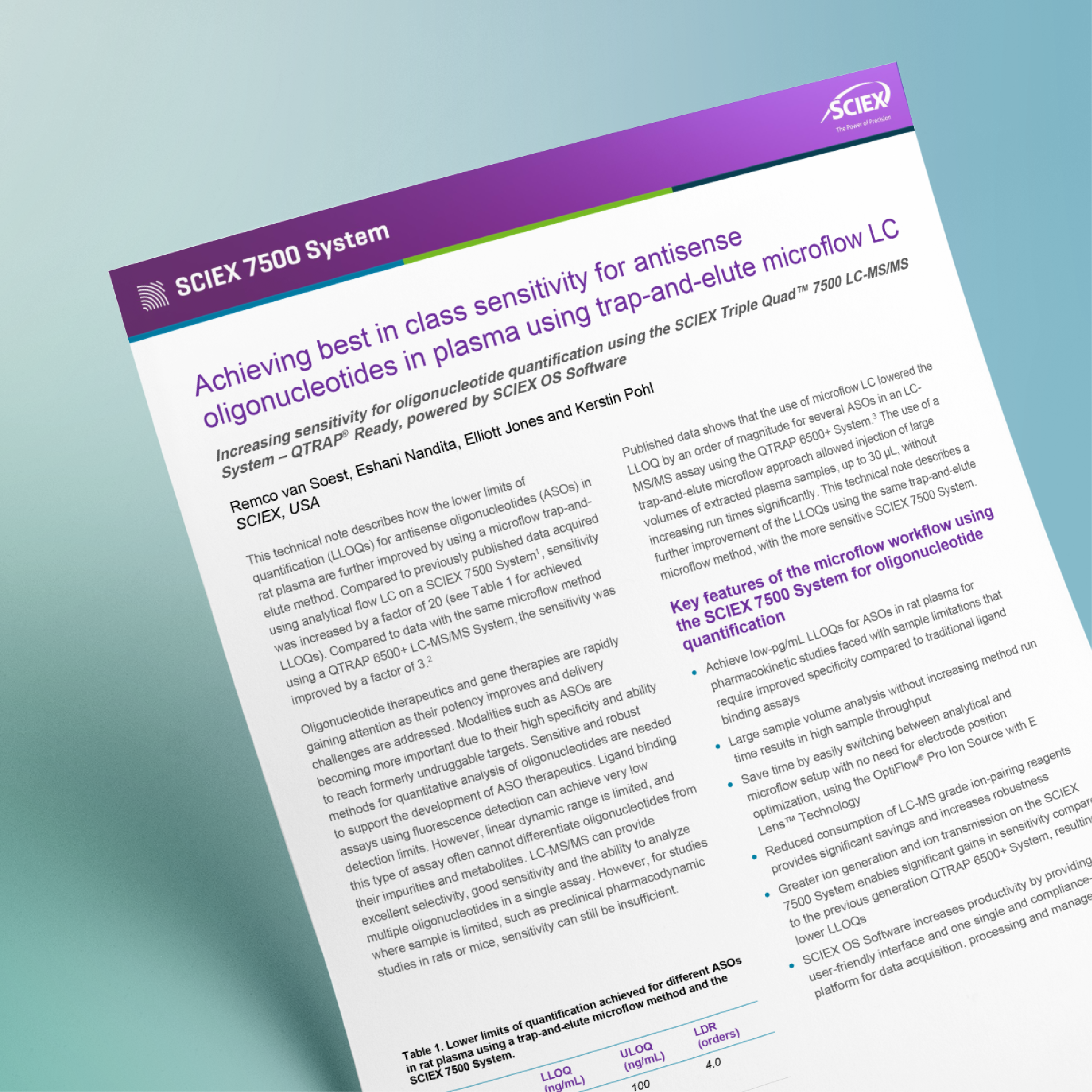
Ultra-low LLOQs for ASOs in rat plasma using a trap-and-elute microflow method
20x improvement in sensitivity for antisense oligonucleotides (ASOs) in rat plasma using a microflow trap-and-elute method
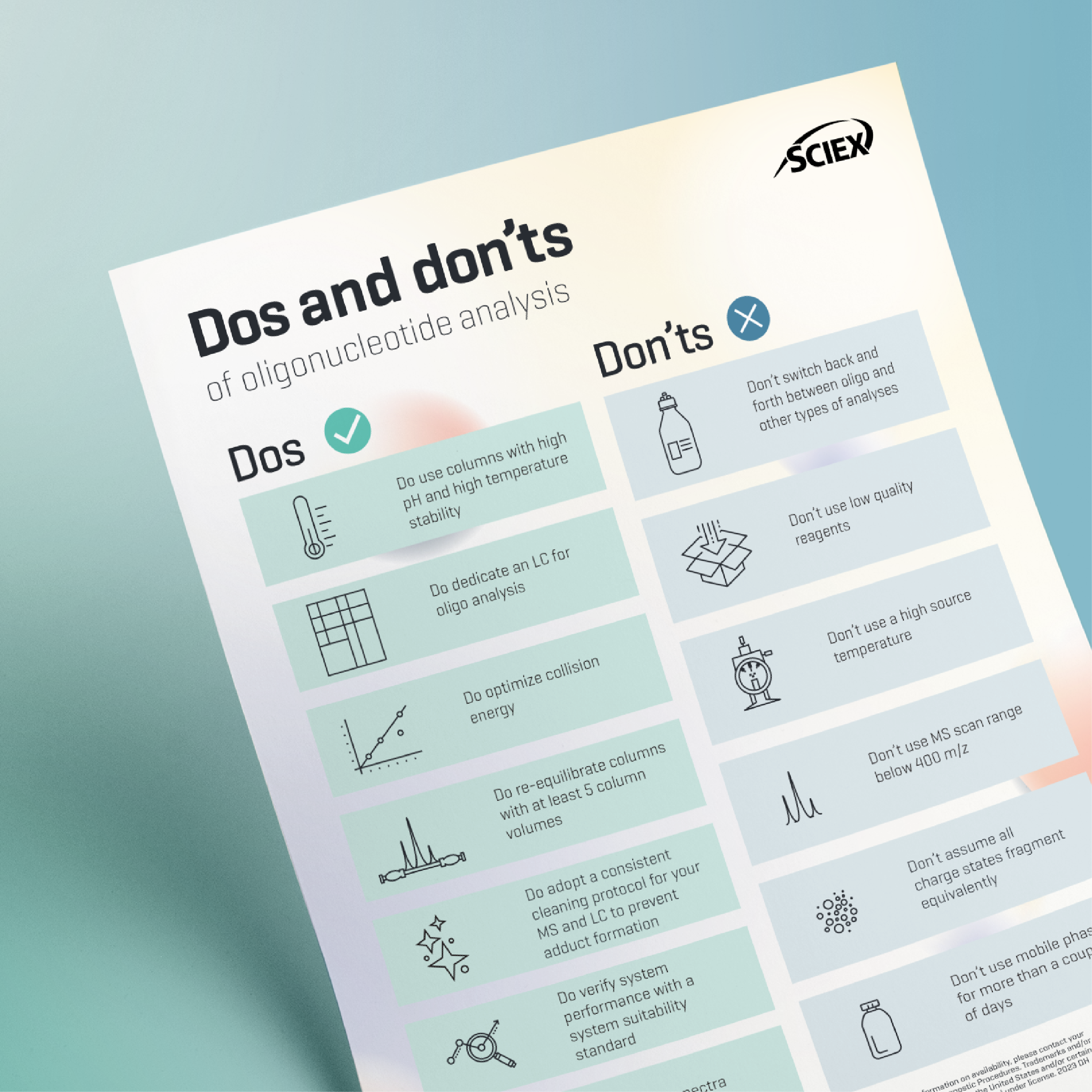
Dos and don'ts of oligonucleotide analysis
Key points to keep in mind when developing your oligonucleotide analysis process
 Peptide quant
Peptide quant

Bioanalytical strategy for quantitation of GLP-1 analogs
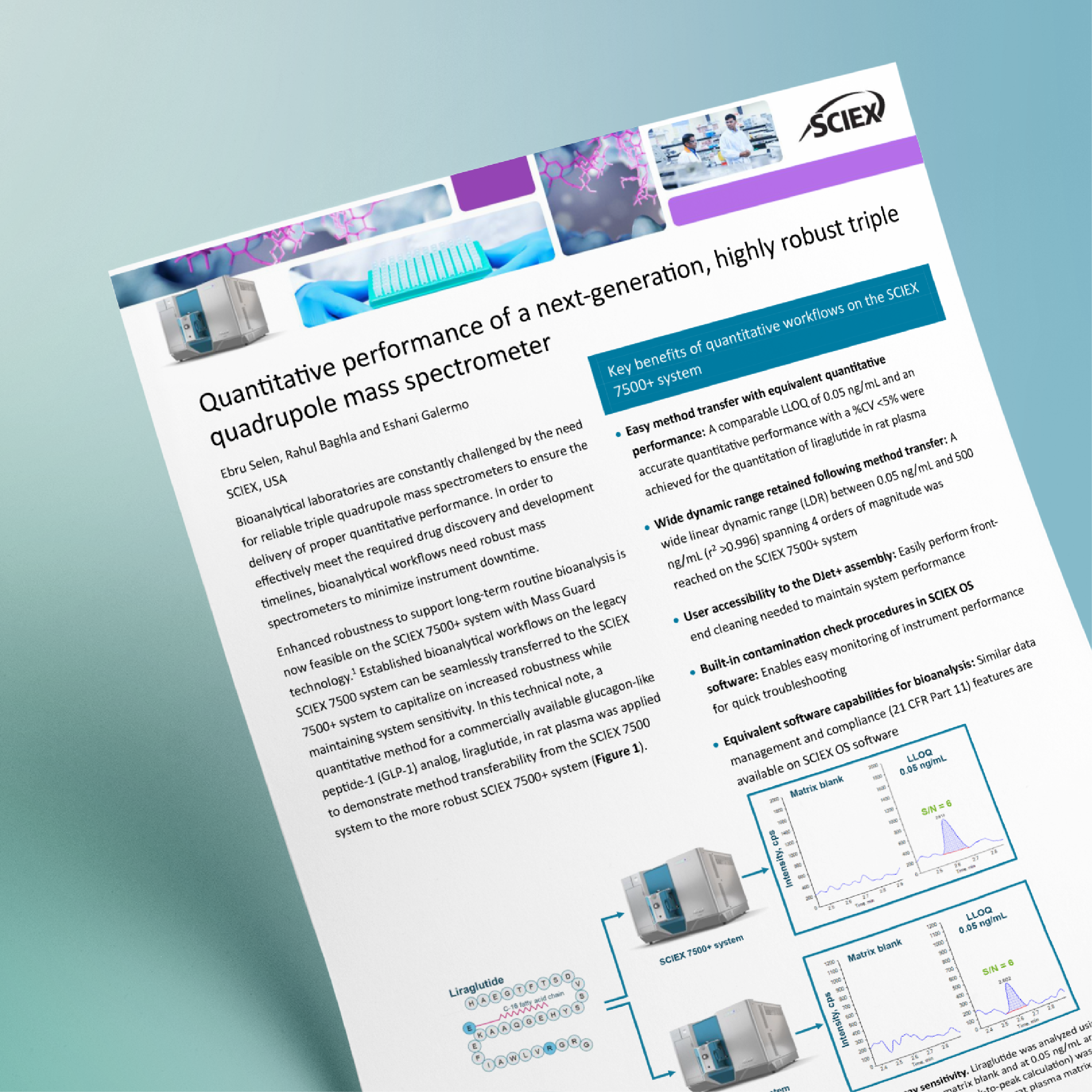
Quantitative performance of a next-generation, highly robust triple quadrupole MS
Bioanalytical laboratories are constantly challenged by the need for reliable triple quadrupole mass spectrometers to ensure the delivery of proper quantitative performance. In order to effectively meet the required drug discovery and development timelines, bioanalytical workflows need robust mass spectrometers to minimize instrument downtime.
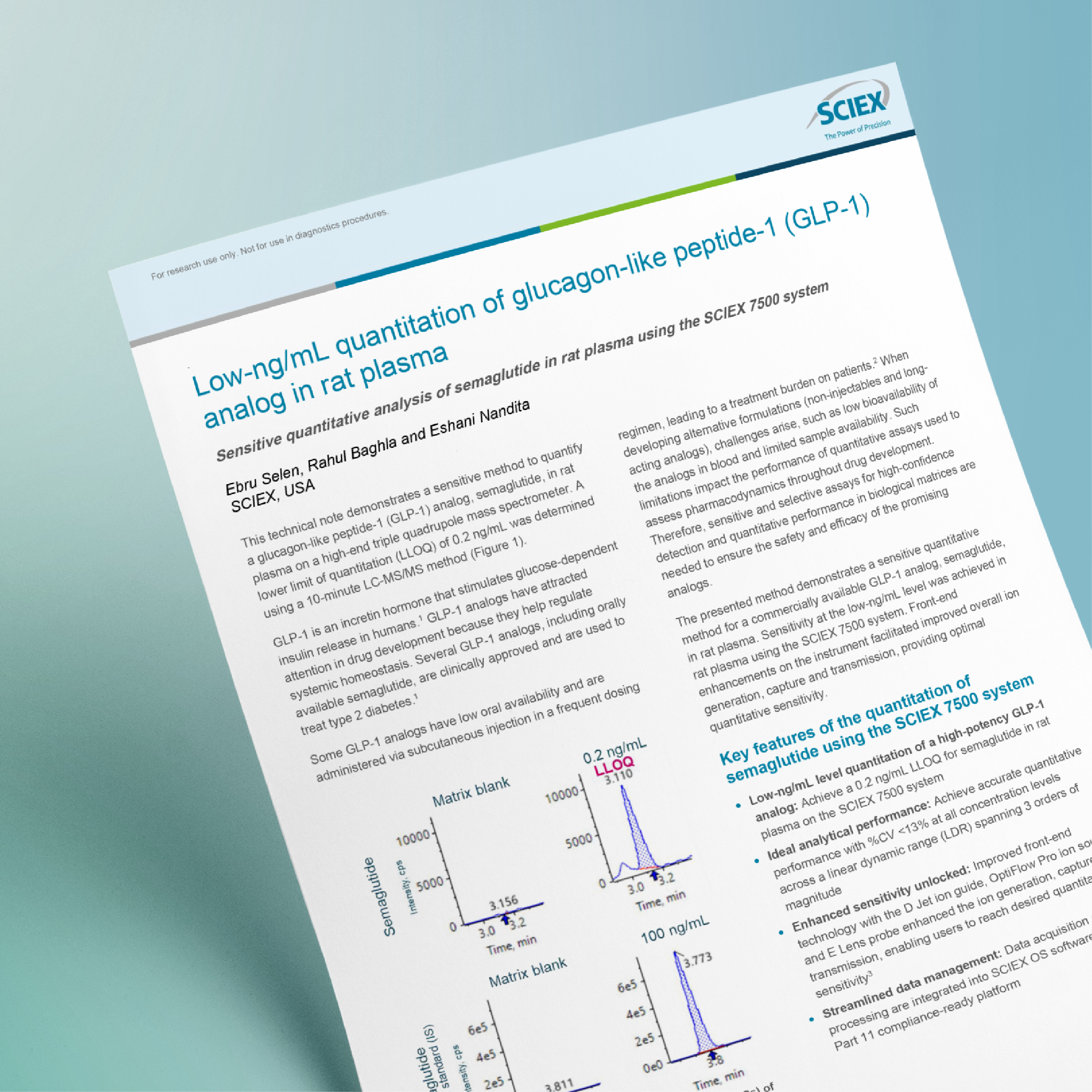
Low-ng/mL quantitation of glucagon-like peptide-1 (GLP-1) analog in rat plasma
This technical note demonstrates a sensitive method to quantify a glucagon-like peptide-1 (GLP-1) analog, semaglutide, in rat plasma on a high-end triple quadrupole mass spectrometer. A lower limit of quantitation (LLOQ) of 0.2 ng/mL was determined using a 10-minute LC-MS/MS method.
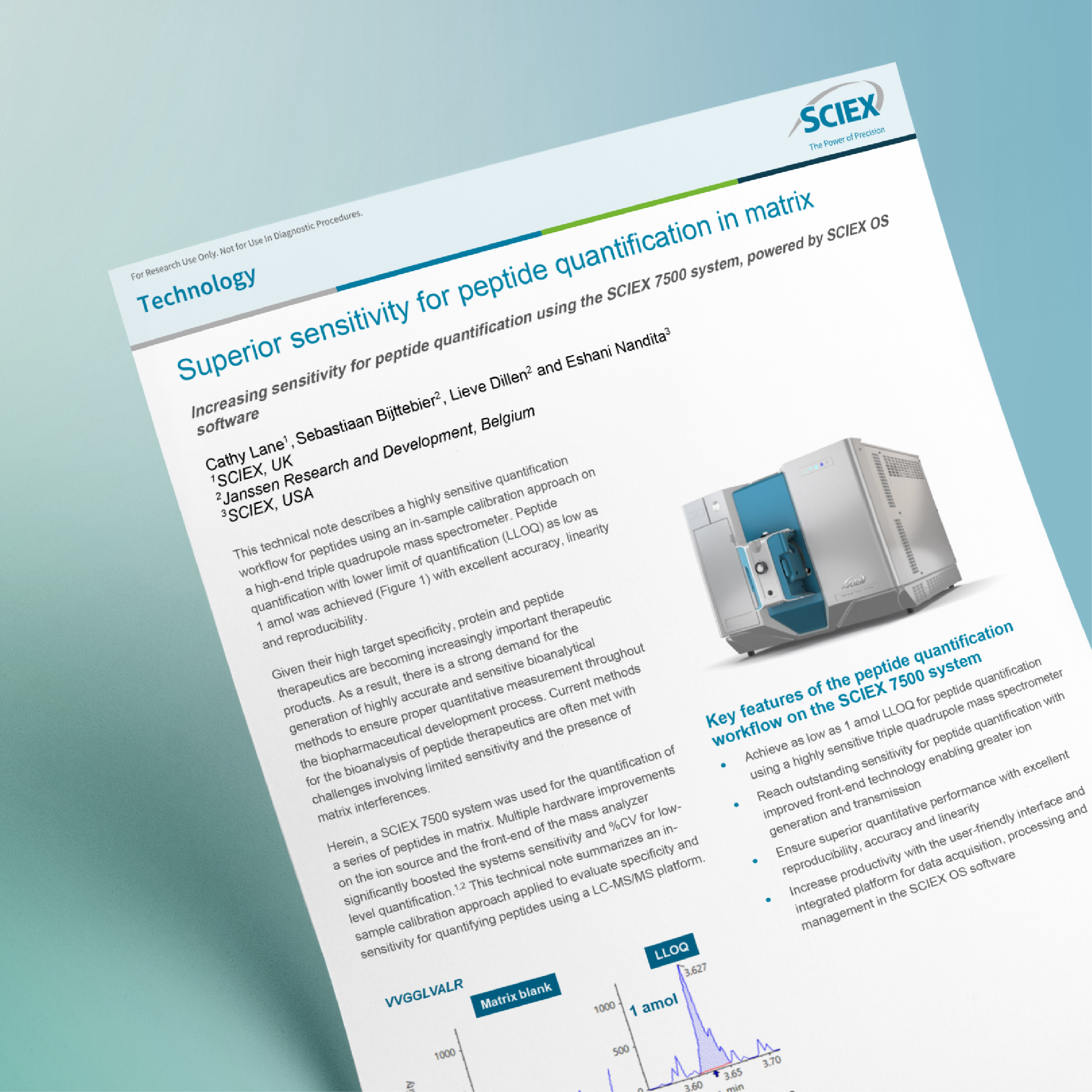
Superior sensitivity for peptide quantitation in matrix
Quantifying peptides at limits as low as 1 amol, with high accuracy, linearity, and reproducibility
![]() Method developer corner
Method developer corner
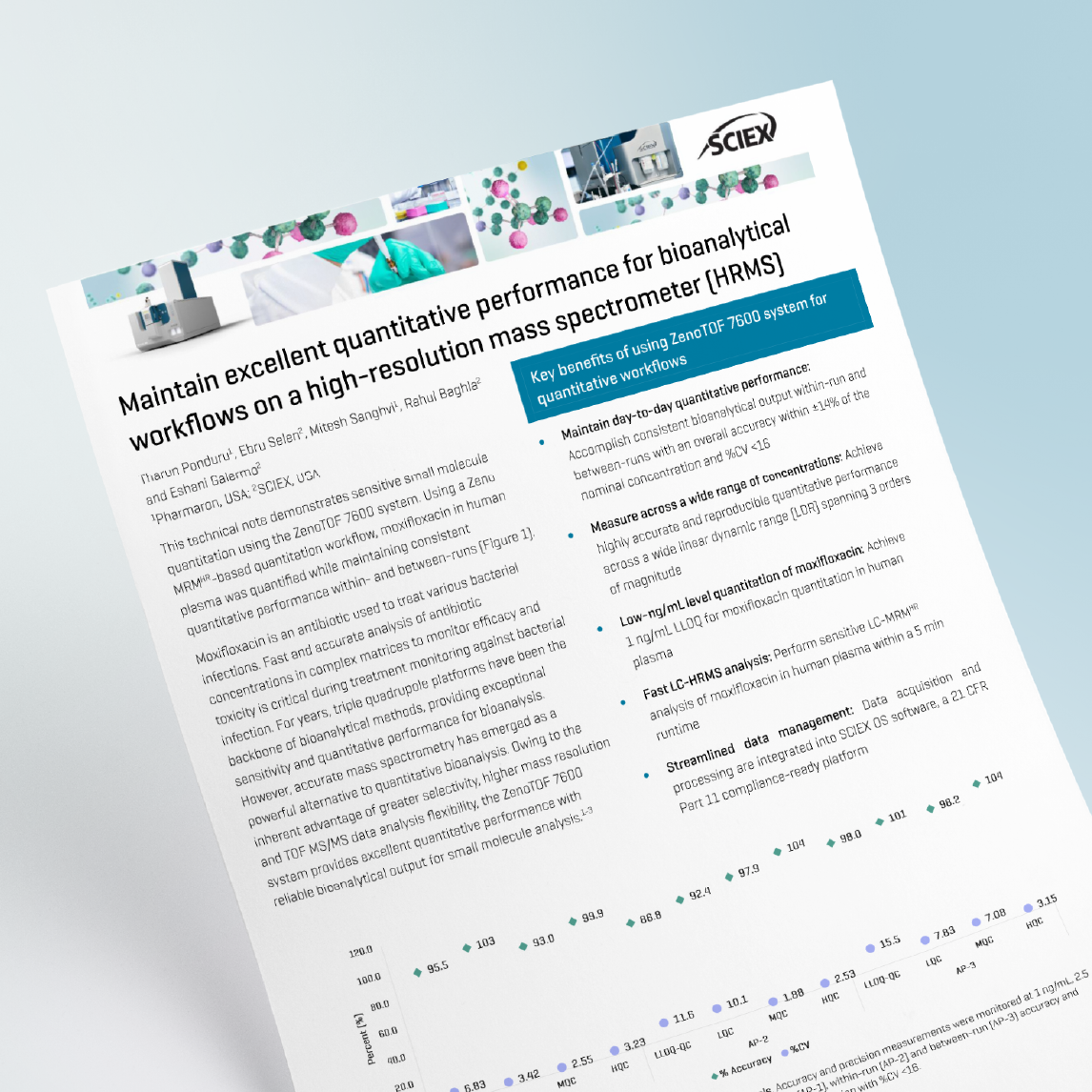
Maintain excellent quantitative performance for bioanalytical workflows on a HRMS

Dos and don'ts of oligonucleotide analysis
Key points to keep in mind when developing your oligonucleotide analysis process.







